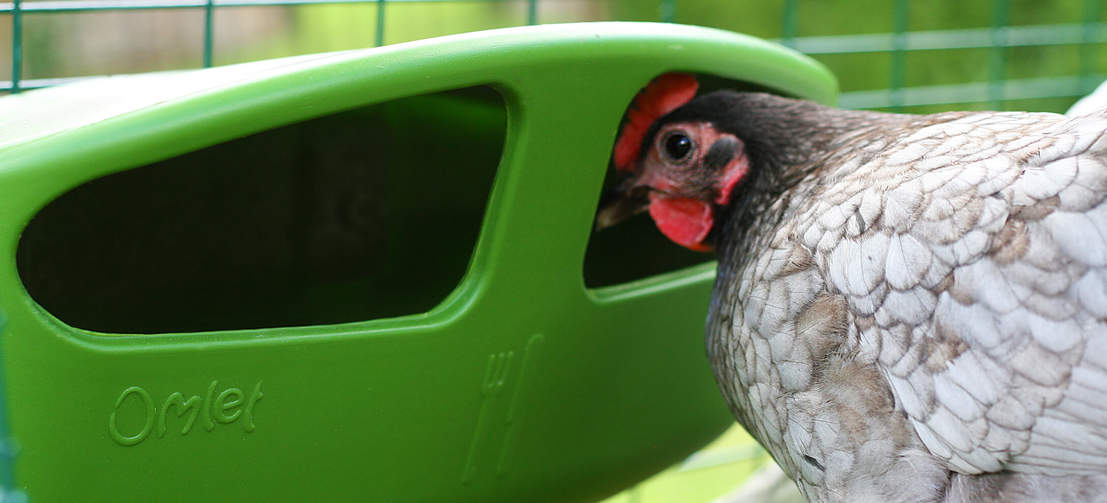
Chickens are great foragers, and free-range birds will peck and scratch for all kinds of wild treats, from grass and weeds to worms and beetles. However, even a hen with all-day access to a garden or meadow still needs to be fed with high-quality layers pellets. These contain the correct balance of protein, carbohydrate, vitamins and minerals (notably calcium for egg shells) that will keep them happy and healthy. Protein is particularly important for healthy egg production.
A general ballpark figure is very useful, to guarantee that the hens’ dietary requirements are being met. For medium-sized breeds such as the Rhode Island Red, Oxford Brown or Orpington, you need to feed between 115 and 120 grams (just over a quarter of a pound) of feed per chicken per day, which is 805 to 840 grams (one and a half pounds) of feed per chicken per week. A slightly larger Sussex will eat a bit more, and the smaller Leghorn will eat slightly less, while a small bantam breed will only eat between a half and three quarters of that amount.
Chicks, Pullets and Layers
Until it is five weeks old, a chick will need to have its diet supplemented with protein-rich ‘chick crumbs’. Between then and 18 weeks old, while they are ‘pullets’, the birds will need ‘growers pellets’ to put on weight. As soon as the hens begin laying, they only need the regular ‘layers pellets’. These, again, are rich in protein, calcium and all the other essential nutrients.
The hens will also need daily access to grit. Treats are fine, as long as they are not being offered so frequently that the hens fail to eat their share of pellets. Corn is a healthy treat, and birds that have free-range access to grass will be in chicken heaven.
How Can You Make Sure Each Hen is Getting Her Share of the Food?
Any flock of chickens develops a natural pecking order, and the dominant birds will tend to eat their fill before the others, if there is not enough space for all the hens to fill their crops at once (something they like doing shortly before retiring for the night). A solution here is to buy a wide-bottomed feeder that allows several birds to eat at once, or to use more than one feeder. This will ensure the timid hens get their fair share of food.
However, as long as you have provided enough for all your hens, there should always be food left in the feeder when the dominant birds have had their fill. You should still keep a close eye on the health of your flock, though. Issues such as soft shells or feather-plucking can be signs of dietary deficiencies, and the problem might lie in the quality rather than the quantity of the birds’ diet.
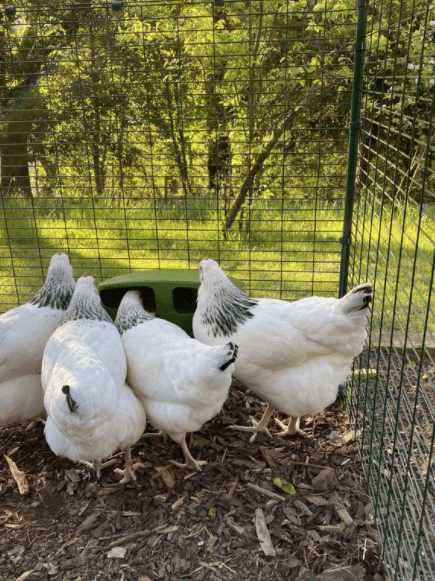
Do Hens Eat the Same Food All Year Round?
Chickens moult every year, and will usually eat more food during this process, to ensure their bodies have all the protein they need to grow a new set of feathers. Hens usually eat more during cold weather, too, in order to fuel their metabolisms and stay warm. Free-range hens also tend not to find as many treats in the garden during the winter, as the insect population is at low ebb and the grass is no longer growing.
You can add a little more food each day during these periods. You will soon know if you are giving them too much or too little, by noting the amount of pellets left in the feeder each evening.
However, the hens produce fewer eggs in the winter, so all in all the amount of protein-rich pellets required does not differ significantly from season to season. Again, the key detail is to ensure a regular supply of food. In the summer, if your hens appear to be eating very little, it may be because they are finding too many good things on their foraging trips in the garden. This can be a problem if the wild food they are filling up on doesn’t provide the right balance of nutrients. You might want to confine a hen to the coop if she doesn’t seem to eat enough pellets. That way, she will be forced to eat the good stuff rather than the garden treats.
Layers pellets should be available to your hens throughout the day – they will eat as much as they need, and will not behave like a dog, eating everything at once simply because it’s there!
This entry was posted in Chickens
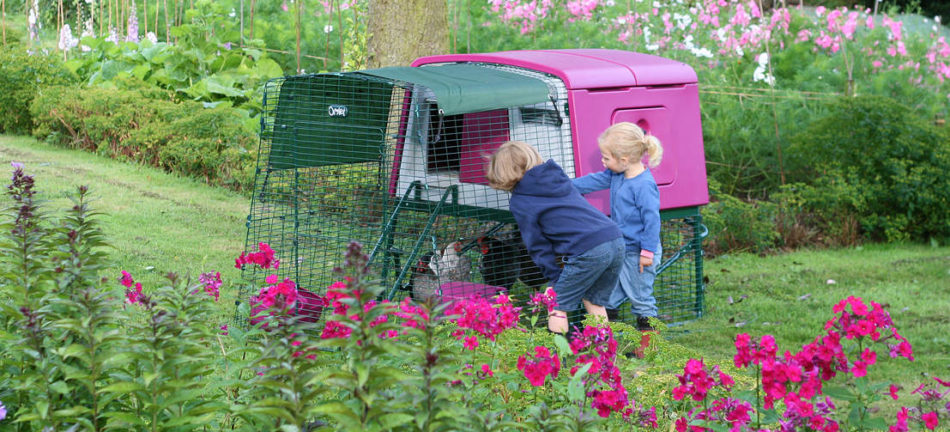
Chickens really are wonderful pets for the whole family. Aside from providing delicious daily eggs, they’re super fun to watch, hang out with, and can teach children valuable life lessons. Compared to other pets, chickens are also relatively low maintenance, and caring for them doesn’t really require much that children from primary school age won’t be able to at least take part in. Read on to find out more reasons why chickens are great pets for families with children.
Responsibility
Having chickens will help children of all ages learn about taking responsibility for another living being. Whilst they should never be given full responsibility for all the chook care duties, even allowing them to scatter some corn for their feathered friends or refilling the drinker can help children build a wondrous connection and gain a better understanding of what it means to take care of another.
Routines
Chickens are pets of routine and part of your daily regime as a keeper includes, but is not limited to, cleaning out the coop and run, filling their feed and waterers and collecting eggs. Having pets that need structure helps children to understand the importance of a routine, which, is something many kids can thrive with,
Food
Keeping chickens will teach your children that food does not magically appear on supermarket shelves. If they care for their own chickens, they’ll hopefully realize how important it is for animals to have enough space and adequate care, and they will not take animal products for granted.
Chickens and children: things to consider
Dream big, start small
Whilst you might be tempted to start off with more, begin with a smaller flock of no more than 5 chickens. That way, your children will easily be able to differentiate them and give them names based on their personalities. Too many at once makes the chickens seem like a flock rather than a group of individuals. And at a later date, there’s nothing stopping you from falling victim to the infamous “chicken math” when your children are older!
Happy hens
Stick to hens. It’s probably a good idea not to get a rooster to start with. Whilst some chicken keepers have their own personal reasons as to why they want to keep cockerels, they’re not for everyone. For one, they’re much more confident and pushy than hens and can be a bit intimidating for younger children.
Easy peasy coop cleaning
Get a coop that makes chicken keeping easy, so that the kids can help. The Eglu Cube chicken coop is perfect for adults and children alike. With the innovative design, even younger members of the family can even help with the cleaning of the coop. Simply empty the dropping tray and wipe down the smooth surfaces of the house once a week, and your coop will look shiny and new every time.
It’s super easy to let the chickens out in the morning and close the coop at night too with the optional Autodoor. Plus, collecting fresh eggs is a breeze with the egg port found on the side of the coop.
Start them young
Even if you’re not incubating eggs and rearing chicks yourself, getting young chickens is a good idea if you want your children to be involved. Encourage regular interaction, and try to pick up the chickens regularly to get them used to being handled. This is sometimes made easier by having the chickens in a run that is easy to access, like the Walk In Run.
Which breed?
There are a number of chicken breeds to choose from, all of which with their own pros. When choosing chickens as family pets though, opt for a friendly and hardy breed that’s renowned for getting on well with kids. Silkies, for example, are famous for being loving and happy to be held, Orpingtons are calm and affectionate and Cochins easily adapt to any situation they are confronted with.
Omlet and your family pet
Whether you’re a first-time chicken keeper looking for a new family pet or expert, Omlet has everything you need to give your chooks the best lives possible. From our range of easy-to-clean chicken coops, to our Autodoor to take the guesswork out of bantam bedtime, chicken keeping has never been more simple or fun than with Omlet.
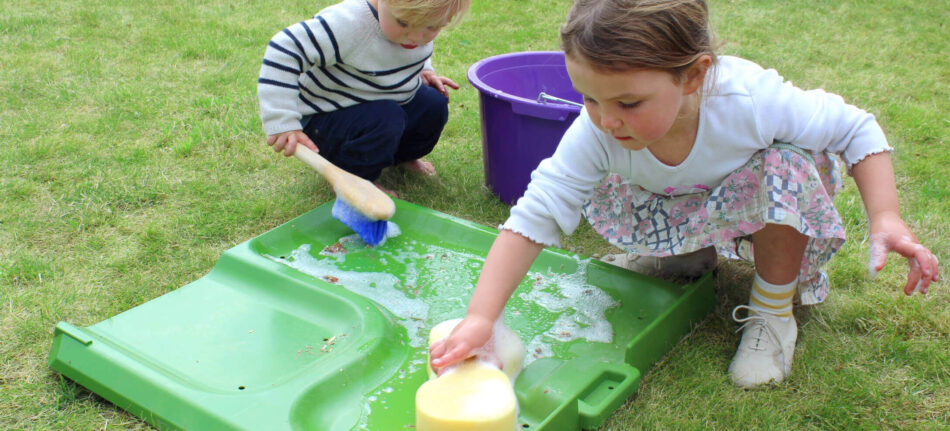
This entry was posted in Chickens
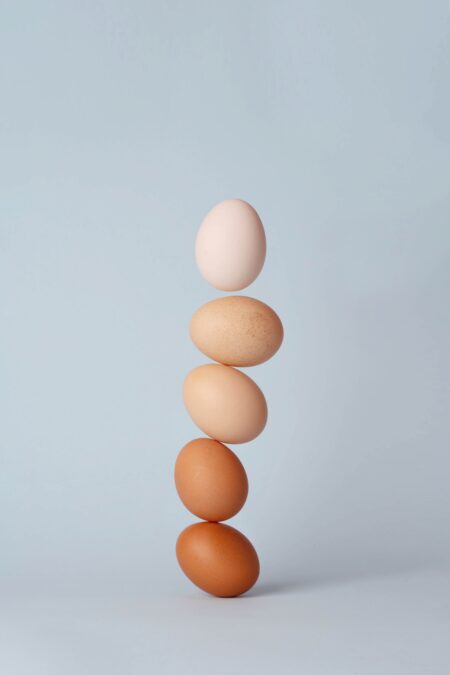 Most people would agree that the yolk is the best part of the egg. A double-yolker in the breakfast pan is therefore a very welcome sight!
Most people would agree that the yolk is the best part of the egg. A double-yolker in the breakfast pan is therefore a very welcome sight!
Some hens lay double-yolkers every time, a genetic quirk that simply means two yolks are released into the system instead of one. However, hens that manage this impressive feat are rare, and no single breed has been developed to pull off the double-yolk trick every time.
The one-egg-with-two-yolks breakfast can still be yours every day, though, if you’re willing to pay extra for it. You may have spotted double-yolk ‘super eggs’ on the shelves of certain supermarkets – sold at a premium, of course – but these are nearly all from young birds, rather than the mythical Double Yolker breed. It’s worth pointing this out, as a Google search will lead to some interesting information about such a breed. But it doesn’t exist – yet!
Most double-yolk eggs encountered by chicken keepers come from young hens. Point-of-lay birds tend to produce a very small egg or two, and then a couple of double-yolkers, before their bodies settle down into a regular four or five eggs-per-week pattern. A double-yolk egg after this early laying stage is very rare in most birds, although some hens begin to produce double-yolkers again towards the end of their egg-laying lives. Circumstantial evidence suggests that the Rhode Island Red, Oxford Brown, Sussex, and Leghorn breeds have a higher chance of producing double-yolkers.
How Are Double Yolks Formed?
Hens’ bodies release a yolk approximately two hours after the previous egg has been laid. Once in the hen’s oviduct – the part of the bird’s body in which the eggs are formed – the yolk is surrounded by the white albumen part of the egg and then covered in hard calcium. If a hen has released two yolks side-by-side, the egg-forming process treats them in the same way as a single yolk, resulting in two yolks ‘trapped’ inside a single egg shell.
If double-yolked eggs are fertilised, the result is two chicken embryos in one shell. Most of these ‘twin’ eggs fail to develop properly, though, with only one chick growing beyond the early development stage, or with neither of them developing. This makes it rare for two chicks to emerge from one egg. Chicken breeders are advised to put aside the double-yolkers to prevent them developing, and in commercial operations most double-yolkers are sold to food companies that use eggs in their products.
How Can You Tell If An Egg Has Two Yolks?
You don’t need to crack the shell to find out what’s inside – you can spot a double-yolker by ‘candling’ the egg. The word candling comes from the ancient practice of holding an egg in front of a candle flame, but a small torch does the job just as well (although they are still ‘candled’ rather than ‘torched’!) If there are two yolks inside, they will be visible as two dark blobs against the bright light as it shines through the shell.
So, although double-yolkers are estimated to occur in just one per thousand eggs, the sheer abundance of point-of-lay hens means that they are a common sight on the plates of chicken keepers around the world.
Triple yolkers, however, are very unlikely to grace the breakfast table. This super-rarity is found in just one egg per 25 million!
This entry was posted in Chickens
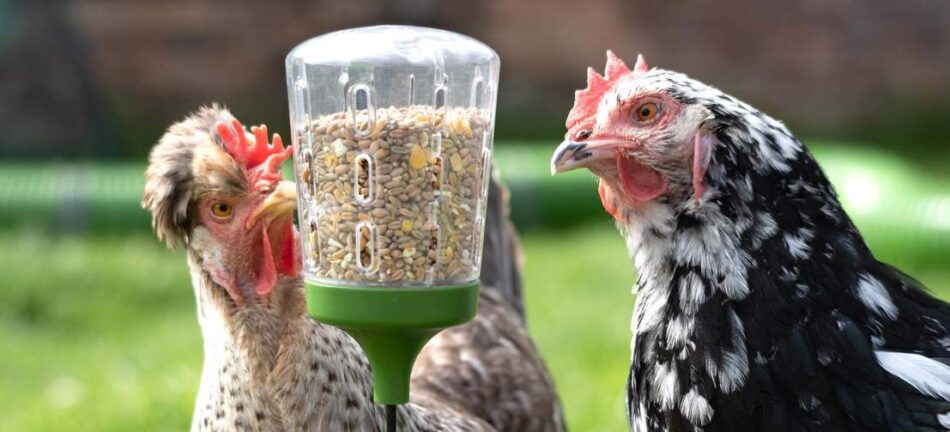
The very short answer to that question is probably no. If you give your chickens a good quality feed and some corn, and let them peck around the garden for insects and small stones they use to grind down their food they should technically be getting everything they need.
Any supplement should be given to your chickens as a complement to a healthy and balanced diet, and not instead of giving them good feed or sufficient space to live out natural chicken behaviours. However, just like you might boost your own system with some extra vitamins and minerals, there are some things that you can give your hens that will help them stay healthier and give them more energy.
Particularly useful at more challenging times, like around a moult or during a particularly tough cold snap, we’ve listed all the supplements you might want to have in your cupboard:
Grit
Chickens don’t have teeth, but use small rocks and stones to grind their food down. Most free range chickens gather grit naturally while exploring the garden, but if you for some reason have to contain your chickens to a smaller area than normal, or if their run is covered in snow, you might need to add grit to their diet.
Make sure to choose something that is chicken specific and will have the right composition and size of components.
Vinegar
Vinegar, normally Apple Cider Vinegar, is a great booster all year around. It aids digestion, keeps internal parasites at bay, and is mildly antiseptic. In the winter it’s also fantastic to use preventatively to keep respiratory infections away from your flock.
Choose an organic or unpasteurised vinegar that contains a substance called ‘the mother’. It’s a gel-like substance that grows naturally on the vinegar, and it’s the mother that contains the most powerful enzymes and minerals that make the vinegar so beneficial.
Vinegar can be added to the chickens’ drinking water, approximately 10ml per liter of water.
Garlic
As well as keeping vampires away, garlic has been used for its beneficial properties for centuries, and it’s a great addition to your chickens’ diet.
You can crush up a fresh clove or use garlic powder to add to the feed. It’s great for circulation, and can help with respiratory infections. It’s also said to help ensure a good appetite, so it’s ideal to give it to newly rescued hens that need a nutrient boost.
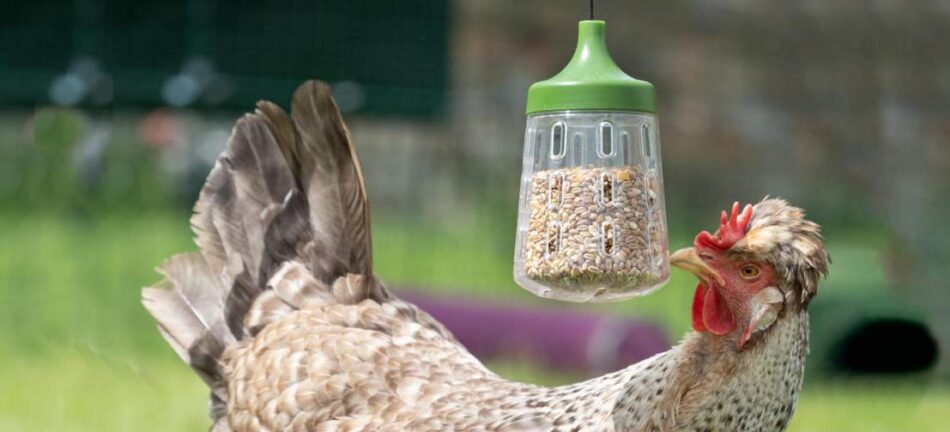
Herbs
Plenty of herbs and spices are said to have medicinal properties that will help your hens keep their immune system in top condition. Verm-X is a 100% natural supplement that helps maintain intestinal hygiene and keeps the hen’s gut and digestive system in great condition, which can help keep parasites and infections away.
Oregano, cinnamon, parsley, turmeric and ginger are other chicken favourites that will increase vitamin levels and aid the immune system, and that grinded down can be mixed into your chickens feed.
Calcium
Chickens use lots of calcium to build egg shells, so laying chickens can sometimes need a little more than they get from their pellets.
Equimins Egg Shell Improver is a great example of a supplement that contains high levels of calcium and phosphorus and will strengthen the quality of your chickens’ eggs. Ideal for ex battery hens or hens going through a moult.
Poultry Spice
This is a long term favourite with chicken keepers, a mineral supplement that will be beneficial to your chickens’ general health. It’s perfect for moulting, or to help maintain good appetite in winter.
This entry was posted in Chickens
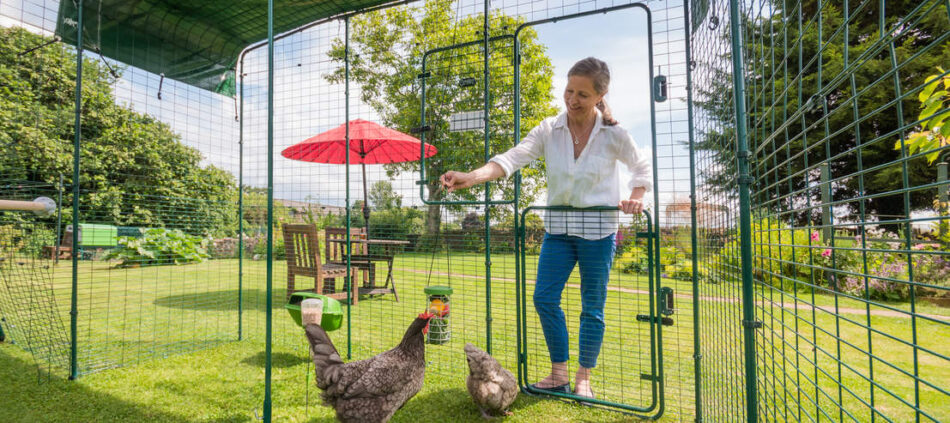
1. You have created a social media page for your Hens
Let’s face it, when you invest in a chicken coop and purchase your first flock you have to share it with friends and family. Whether it is documenting first eggs laid in the coop to your gourmet recipes with your farm-fresh eggs you are posting it on Instagram, Facebook, or Twitter.
2. You find eggs throughout the house
As you start becoming more comfortable with your chickens maybe you decide to let them into your home. They never bother anybody and get along great with your other pets but occasionally you find a fresh egg in your fruit bowl or on top of your favourite armchair. Hey, at least you know they are comfortable!
3. A “staycation” is your idea of a holiday
When you invest in your first brood you feel like you are a second parent to these animals. You wash them, feed them, and make sure they are comfortable. Add that in with taking care of your own kids and the idea of going on holiday is the last thing on your mind. You would much rather set up a zoom background of the beach or the tropics, order in a favourite meal, and put your feet up. Ahhh!
4. You find yourself chatting with your chickens
Sometimes we just need a good therapy session with an attentive listener, and who better than your chickens. They will never talk back to you or judge you for your decisions. They may give the occasional nudge or peck for a pet but hey, it is cheaper than therapy.
5. You have pet names for your hens
After the first couple weeks of tending to your chickens you start noticing some have different personalities. Some are on the shy side, some are very particular about their feeding time, and some just want all of the cuddles in the world. What a perfect time to give them a name! Whether it is Rudy, Cleo, or Fluffy we don’t judge here because they are your pets.
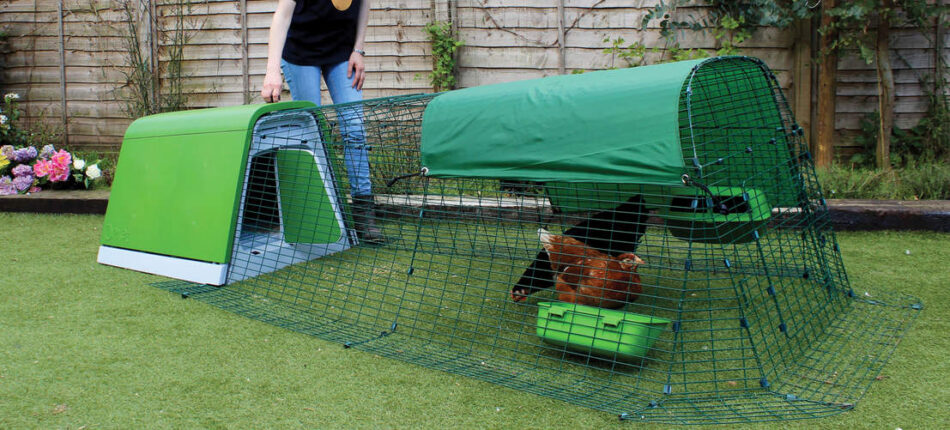
6. The home is filled with fashionable fowl décor
Whether it is chicken cocktail napkins or a hen-tastic serving platter you or your friends have made sure that you have all of the latest in chicken-related home furnishings.
7. You have a carrier bag to transport your chickens
Maybe you need to take them to the vet like any of your other pets. Who says that they shouldn’t be comfortable? That is why you have the top of the line carrier to transport your chickens whenever they are unwell.
8. Dressing up your brood for special occasions
When you have spring chickens or fall fowls they must be dressed for the season. When Halloween comes around you wouldn’t put it past yourself to dress up your chickens in a matching outfit with your other pets.
9. Instead of walking the dog you find yourself walking the flock
Yes, there are harnesses for chickens because you have already researched it on Amazon. Maybe you have limited land and your chickens need to stretch their legs each day, so you take them to the local park to graze and get some fresh air. Totally normal, right?!
10. You find yourself building a chicken picnic table for feeding time
We have all seen the trend of building mini picnic tables for our squirrel friends in our backyard. If you haven’t just Google it and you will be entertained by these structures. Well, who says your chickens should have any less than the squirrels. You paint your own table to pour your chicken feed into each day so your chickens can chow down in style.
At the end of the day, we understand that when you decide to venture out into the land of chicken coops it can be a daunting process. Everyone has unique experiences and should be able to tend to their hens/ roosters in their own way. Your flock is part of your family so why skimp on their care and upkeep!
This entry was posted in Chickens
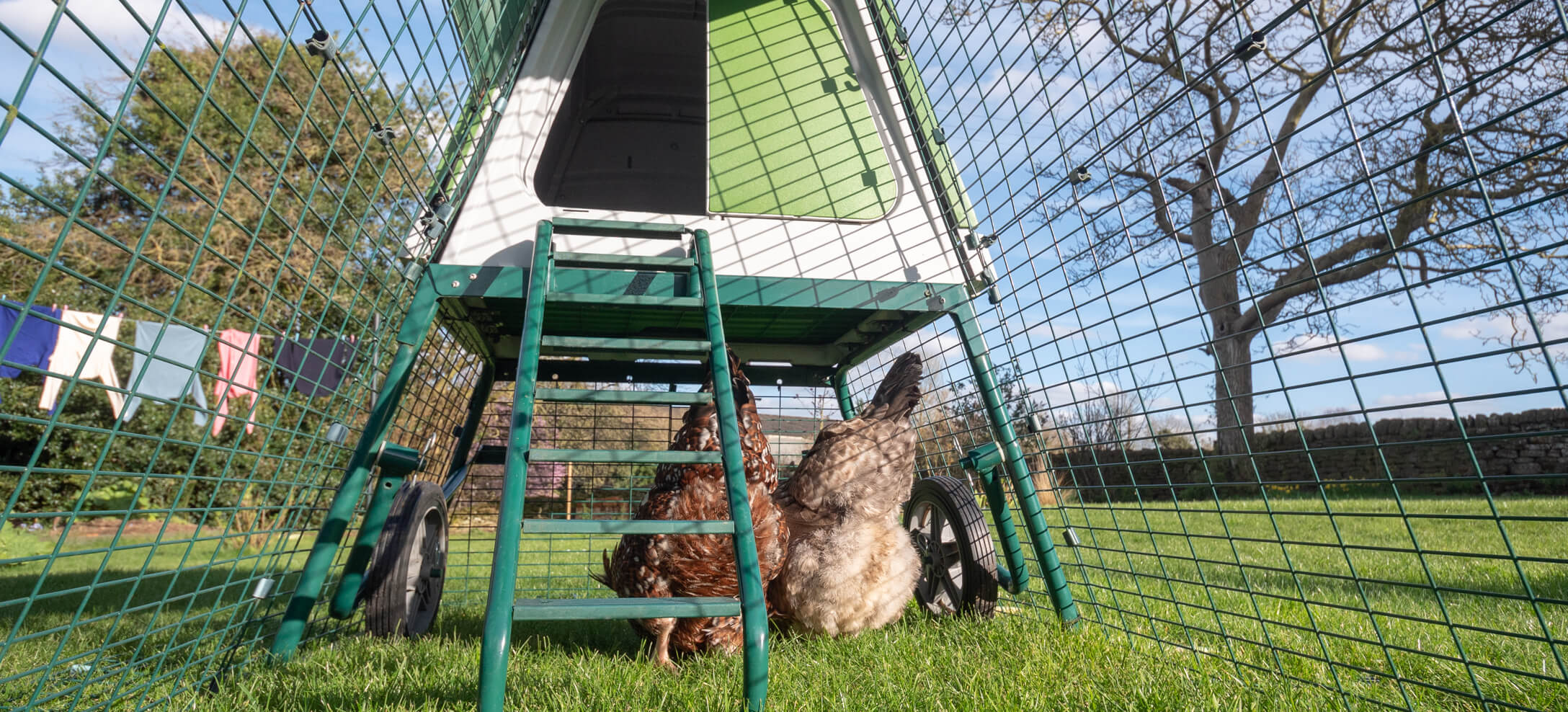
Like most other animals, chickens can suffer from parasitic worms. These are endoparasites that live inside your bird’s body, and are collectively called Helminths by vets.
Does my chicken have worms?
The three types of parasitic worms that your chickens are most likely to contract are:
- Roundworms. There are a number of different roundworms, with the large roundworm being the most common. They live anywhere in the bird’s digestive system, and can sometimes be spotted in your chickens’ droppings.
- Gapeworms. These nasty parasites attach themselves to the trachea of the chicken, hooking on without moving.
- Tapeworms. These attach themselves to the lining of the intestine and can get really long and unpleasant. They are less common, but will more significantly affect the bird.
It’s not always straightforward to tell if your chicken has worms, but symptoms may include a paler comb, decreased egg production, diarrhoea and increased appetite without weight gain. A chicken who has been infected with gapeworm will stretch their neck and gasp for air. Sometimes you won’t spot an infection until it’s really serious and possibly untreatable.
To worm or not to worm
Many chicken keepers therefore choose to worm their chickens regularly to prevent them getting infected, usually once in spring and once in autumn. This is normally done using Flubenvet, a poultry specific wormer you can get at the vets that will kill both the worms and their eggs. Make sure you get a worming treatment that is suitable for chickens, and check if you should be discarding the chicken’s eggs while she is being treated. Always worm all chickens at the same time.
Other chicken keepers think it’s better to only treat chickens that have a confirmed infection. This is partly because some wormers are only effective on particular parasites, and will be pointless if your chickens have a different type of worm. Some also think it’s unnecessary to stress the system by giving the birds treatment for an issue they might not have. Additionally, it can be pricey to worm a whole flock twice a year.
If you don’t want to treat your chickens without a diagnosis, but suspect they might have worms, you can get their droppings tested for presence of eggs. Ask your vet if they will do it for you, or you can send the droppings off to a laboratory in pre-made kits.
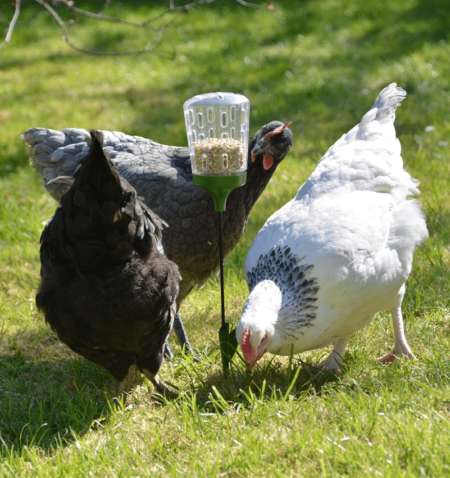 Prevent infections
Prevent infections
Whether you decide to treat only confirmed worm cases or worm preventatively, it’s always best to do everything you can to make sure your chickens don’t contract parasites.
One of the best things to do is to regularly move their coop and run to a new patch. This will stop serious outbreaks, as it stops the life-cycle of the worms. Worm eggs are expelled in the droppings from infected birds, and survive on the ground for a surprisingly long time before they are picked up by foraging chickens. This is called a direct life-cycle, as the worm doesn’t need a host animal to get to your hens. Worms that have an indirect life-cycle on the other hand let their eggs first be ingested by for example earthworms, slugs or centipedes, where they lay dormant until the host is eaten by one of your chickens. The larvae hatch inside your hens, and the cycle repeats.
To prevent an unbreakable chain of worm infestations, it’s therefore important to regularly move your chickens. This is made easy by portable chicken coops like the Eglu Cube or the Eglu Go UP.
Another useful thing is to keep the grass mowed as the ultraviolet light from the sun can kill off potential worm eggs in your chickens’ droppings. Clean the run every week and scoop up droppings and wet bedding. If one of your chickens is infected it’ll be very difficult to get rid of all worm eggs from the ground, but every little helps!
Finally, many chicken keepers swear by the mineral supplement Verm-X. It’s a herbal formulation that works to create an environment in the gut that is able to eradicate and expel any intestinal challenges. This can be given as a supplement to your flock regularly to help their immune system stay on top.
This entry was posted in Chickens

Take this opportunity to get some good quality feed that will keep your chickens happy and healthy this autumn! When you sign up to the Omlet Newsletter on this page (for the feed) or this page (for the Easichick Bedding), you will receive a unique promo code that gives you free delivery on your feed or bedding – for a limited time only!
The offer is available on your pick of two bags of Omlet’s Organic Chicken Feed, Omlet’s Organic Mixed Corn, Organic Omlet Chicken Feed 10kg and Mixed Corn 10kg or Organic Omlet Chicken Feed 10kg Twin Pack, or two bags of Easichick Bedding!
Terms and conditions
This promotion is valid while stocks last, until midnight 05/11/20. Once you have entered your email address on the website you will receive a unique discount code that can be used at checkout. By entering your email you agree to receive the Omlet Newsletter. You can unsubscribe at any point. The offer of free delivery is available on Omlet’s Organic Chicken Feed, Omlet’s Organic Mixed Corn, Organic Omlet Chicken Feed 10kg and Mixed Corn 10kg and Organic Omlet Chicken Feed 10kg Twin Pack, or Easichick Bedding. The offer does not include any non-Omlet branded feed. Excludes grit. Excludes any other type of bedding. Offer is limited to 2 bags of feed per household, or 2 bags of Easichick. Free delivery only applies to the included products, delivery charges will be added for other items added to the order. Free delivery offer is not redeemable on pallet deliveries. Omlet cannot take responsibility for third party supplier delays such as courier service. Free delivery is only valid for orders sent to mainland UK, and only applies to Standard Delivery Service. Subject to availability. Omlet ltd. reserves the right to withdraw the offer at any point. Offer cannot be used on existing discounts or in conjunction with any other offer.
This entry was posted in Chickens
Making sure your flock is healthy and happy is the responsibility of all chicken keepers. Knowing how to give your chicken a health check will enable you to see that all of your hens are feeling their healthiest. When combined with adequate shelter, nutrition, and enrichment, regular health checks will help your chickens live long, healthy lives. Learn when and how to give your chickens health checks, and familiarise yourself with what’s normal so that you can recognise when something is amiss.
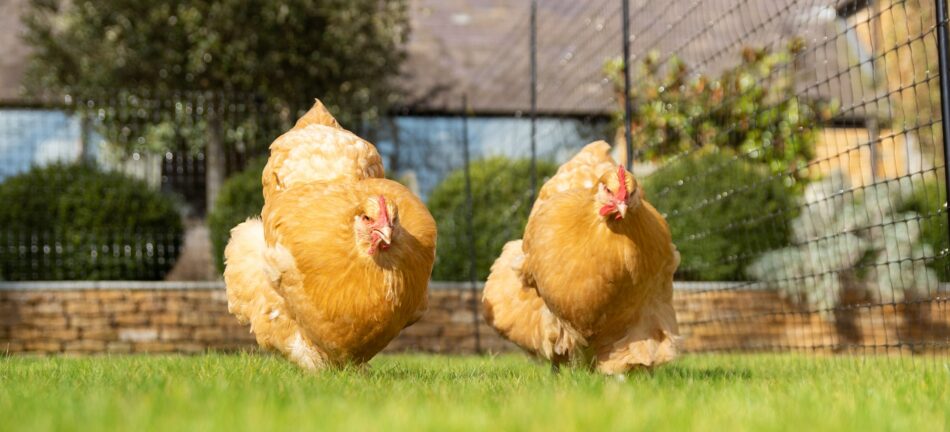
Why are chicken health checks important?
Like other pets, injuries and illness can occur in chickens. Since chickens are prey animals, they are masters at hiding pain and weakness. So while some illness or injuries may seem to occur suddenly to the untrained eye, there may be subtle hints that can be detected through routine health checks.
Routine chicken health checks will also give you a baseline for what’s “normal” for each individual hen. By knowing how your chickens normally look and feel, you’ll be able to more quickly identify a potential issue. Time is of the essence when your chickens are feeling “off” — making regular health checks a vital part of your flock-care routine.
How often should I give my chickens a health check?
It’s likely that you’ll observe your chickens daily as they go about their business in the yard or run. But weekly chicken beak-to-tail health checks are best for heading off potential problems. Each week, handle your hens and go through this checklist:
Eyes
Your chicken’s eyes should be clear, bright and fully open. Any amount of discharge, whether clear and watery or thick and yellow or green, is abnormal. Their eyes should also be properly lubricated and not appear dry, and third eyelids should slide easily and retract fully.
Nose
Nostrils, or nares as they are called in chickens, are located on the top of the beak near the eyes. Nares should be clean and free from debris, and should not have any discharge. Breathing sounds should not be audible.
Beak
Your chicken’s beak should be smooth, without cracks or other damage. The top and bottom should align, with the top being slightly longer. Healthy chickens keep their beak closed most of the time.
Comb
A grown chicken who is not broody or moulting should have a firm, bright red comb. It should be positioned according to the breed standard, i.e. if the breed’s comb is upright, it should not be hanging or looking shrivelled.
It’s especially important to check combs and wattles in winter, as they are prone to frostbite. Larger combs can be protected by a daily layer of vaseline.
Crop
Chickens have a “crop” at the base of their esophagus that holds their food before it’s moved through the rest of their digestive system. You can feel the crop by palpating by the breastbone of your chicken at the base of their neck. It’s easiest to feel when your chicken has just eaten — it will feel firm and about the size of a golf ball. Empty crops usually can’t be felt.
When you first let your chickens out in the morning their crops should be empty, as they should have spent all night digesting their food. After eating, the crop will feel firm, but not rock-hard. If it never feels empty, full even after not having food all night, or if your hen’s breath is foul smelling, you could be dealing with an impacted or sour crop.
Feathers
With the exception of molting season in chickens, your hens’ plumage should be full and shiny. Bald patches, broken feather shafts, or unkept feathers can all be signs of stress, parasites, or behavioural concerns.
Legs and feet
Your chicken’s legs should appear smooth, with the scales lying flat against the bone — raised or dry scales can be an indication of scaly leg mites. The bottoms of the feet should be smooth and free of cuts, discoloured spots, or bumps. Large bumps on the bottoms of the feet can indicate bumblefoot in chickens, which is a bacterial infection.
Vent
The vent, or cloaca, of chickens is where eggs and eliminations are expelled from the hen’s body. Laying-age hens have pink, wide, and moist vents, while vents in older hens may appear dry and more pale. Healthy vents should never protrude or appear injured. Mites and lice gravitate toward this area, so check for black specks of debris or skin irritation.
Droppings
Slide out dropping trays, like those on Eglu chicken coops, help you keep an eye on your flocks eliminations. Chicken droppings should be formed and somewhat firm, and dark brown in colour. Loose, white portions on these droppings are also normal. Your chickens’ droppings will vary depending on their diet for the day, but should always revert back to “normal” within a day or two of eating new or diverse foods. Extended periods of loose stool, or bloody stool is an indication of illness or stress.
What to do if your chickens aren’t feeling their best
If any of your findings during the chicken health check are abnormal, it’s best to separate the affected hen from the rest of the flock and contact your veterinarian for further guidance. Make sure that you have a veterinarian that treats poultry as a point of contact. Some veterinarians may be able to come to you, or give you advice over the phone on how to proceed with any chickens that feel under the weather or that appear injured.
Isolate ill or injured hens until their symptoms have cleared, or until you’re advised by your veterinarian that it’s ok to reintroduce them back into the flock. Having a back up chicken coop to serve as a hospital wing or quarantine coop is always a good idea. This will ensure that the chickens that any chickens that aren’t feeling their best will still be housed in the best accommodations possible — which will help aid in reducing their stress and boosting their recovery.
Omlet and your healthy hens
A healthy flock starts with their housing and care. Our chicken coops are easy to clean, and offer the support and security that your flock needs. When they’re not sleeping or laying eggs in their coop, your hens will enjoy their time outside safely inside our walk in chicken runs, protected from predators. Add chicken run weather covers, and your flock will be ready to enjoy healthy, happy seasons in their home with you.
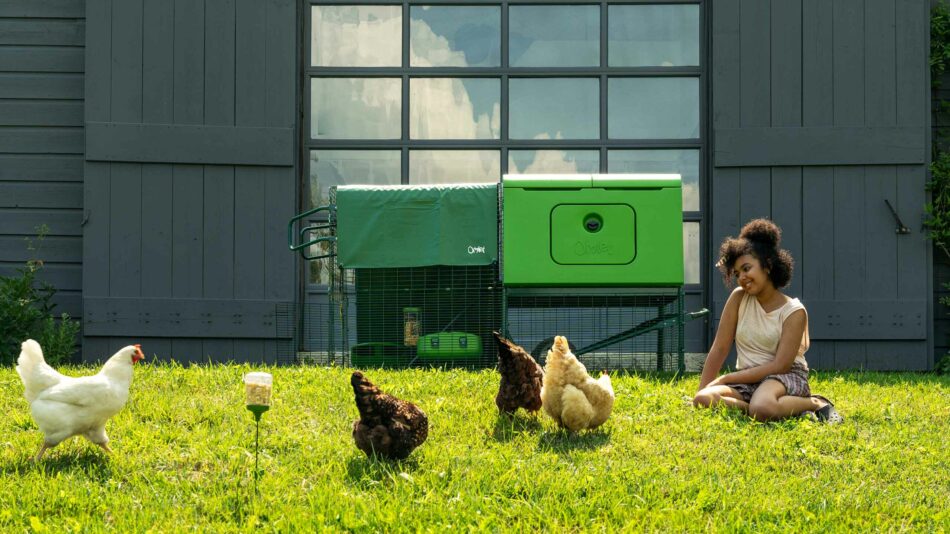

This entry was posted in Chickens
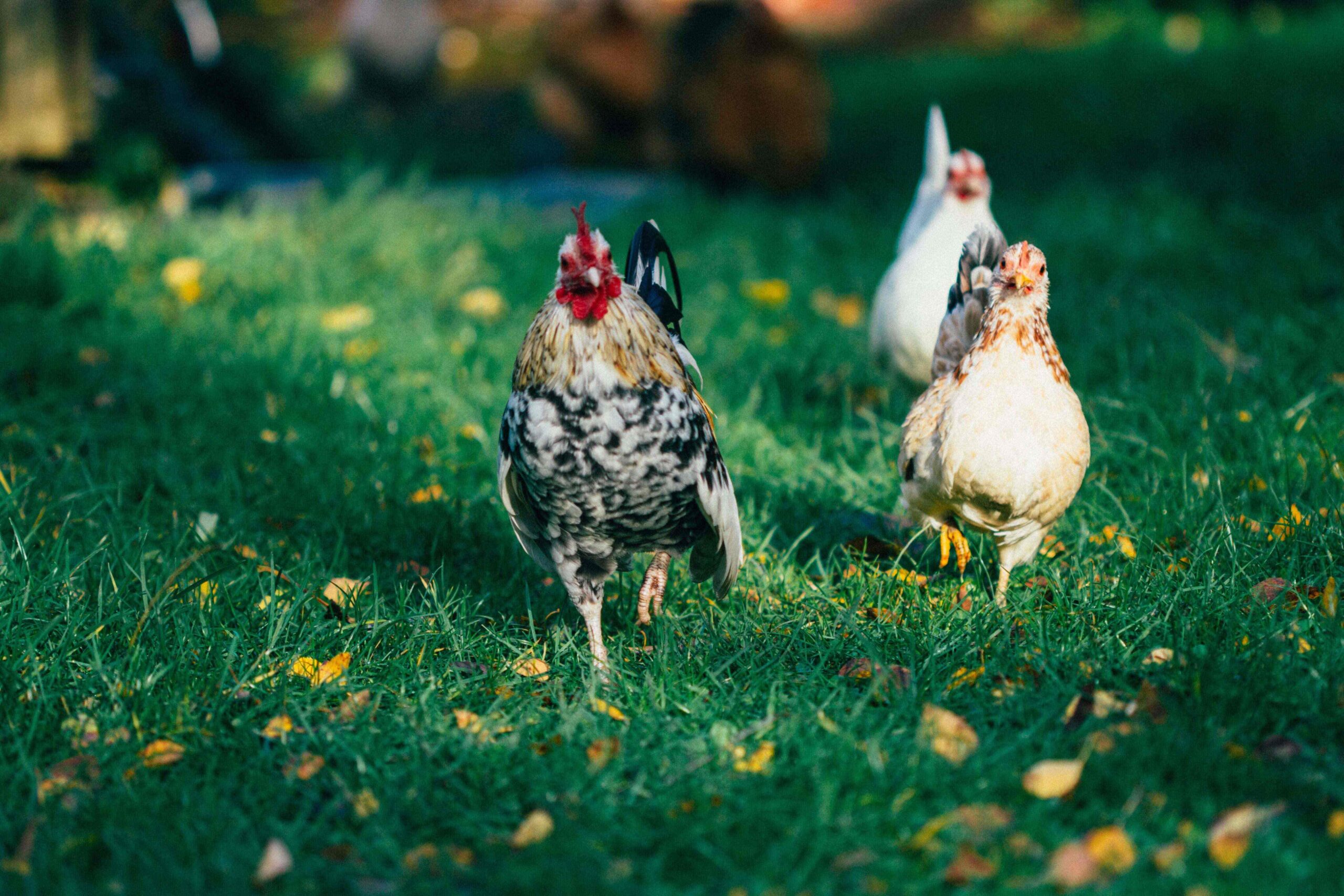
Chickens are colour blind
FALSE – Chickens actually have superior colour vision to humans. Thanks to five light receptors in the eye (humans only have three), they can see many colours more vividly than us.
Chickens can be half male, half female – split down the middle
TRUE – Due to a phenomena called bilateral gynandromorph there are chickens where one side of the body is male (large wattle, spur and muscular breast etc.) and the other side is female (duller plumage, smaller comb, slighter build etc). Worth a google!
There are as many chickens as there are humans on earth
FALSE – There are almost 4 times as many chickens as there are humans, more than 25 billion. In fact, there are more chickens in the world than any other bird.
Chickens navigate through magnetic fields
TRUE – Like other birds, chickens use the magnetic fields of the earth to orientate themselves and navigate around their home environment. Additionally, studies show that chickens use the sun to tell the time of day. Daylight intensity is also what tells cockerels when to crow in the morning and when to go roost at night.
Chickens are cannibals
UNDECIDED – You might have heard about cannibalism in poultry, and it does happen that chickens start pecking the flesh of other hens. This is however not a natural behaviour seen in the wild, but a result of a stressful environment with limited space in large egg or meat factories. A happy chicken will not eat its friend.
Chickens have no taste buds
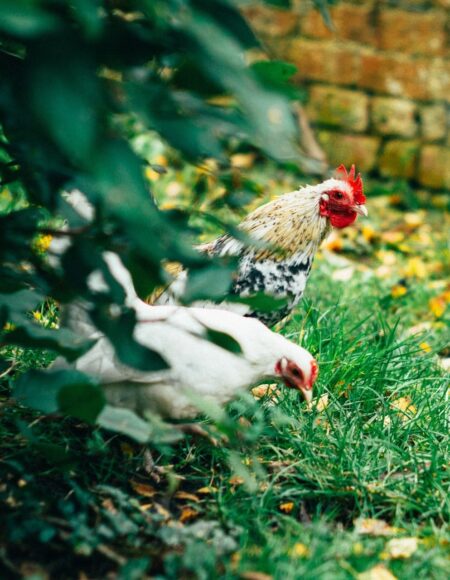
FALSE – While it may seem like chickens will eat just about anything you put in front of them, they do have taste buds, and personal preferences. A chicken can’t taste sweetness or spiciness, but can tell saltiness, sourness and bitterness apart.
The colour of the egg affects the nutritional content
FALSE – Despite what some egg producers have claimed during the years, brown eggs are not healthier than white ones, or vice versa. The colour of the shell only depends on the breed of chicken it came from, and will have no impact on taste or nutritional content.
If you chop their heads off, chickens will keep running
TRUE – Some chickens will indeed keep running after having their head chopped off. The pressure from the axe triggers nerve endings in the neck, sending a message back to the muscles telling them to move, without the brain actually being involved.
The chicken is then moving while actually being dead, but in the case of Miracle Mike, the farmer who tried to kill him aimed a bit high and accidentally left a bit of the brain that chickens keep at the back of their necks. This made it possible for Mike to live for another 18 months (!) after his head had been removed.
You can hypnotise a chicken
TRUE – There are several ways of putting a chicken in a trance, but the most common one involves holding the chicken with its head close to the ground, and drawing a line in the ground going outwards from the beak. This will paralyse the chicken, and she will stay laying still until you clap or poke her.
While it probably won’t hurt your chicken to hypnotise it like this, it’s unclear how much stress it causes her, so make sure not to do it too frequently.
This entry was posted in Chickens
Hens are always talking amongst themselves. All those clucks and squawks mean something, and while some of the meanings of these chicken sounds are obvious – the explosive squawking of a bird running away in panic, for example – others are more subtle.
Here are ten ways in which you can eavesdrop on the chicken chat and brush up on the bantam banter.
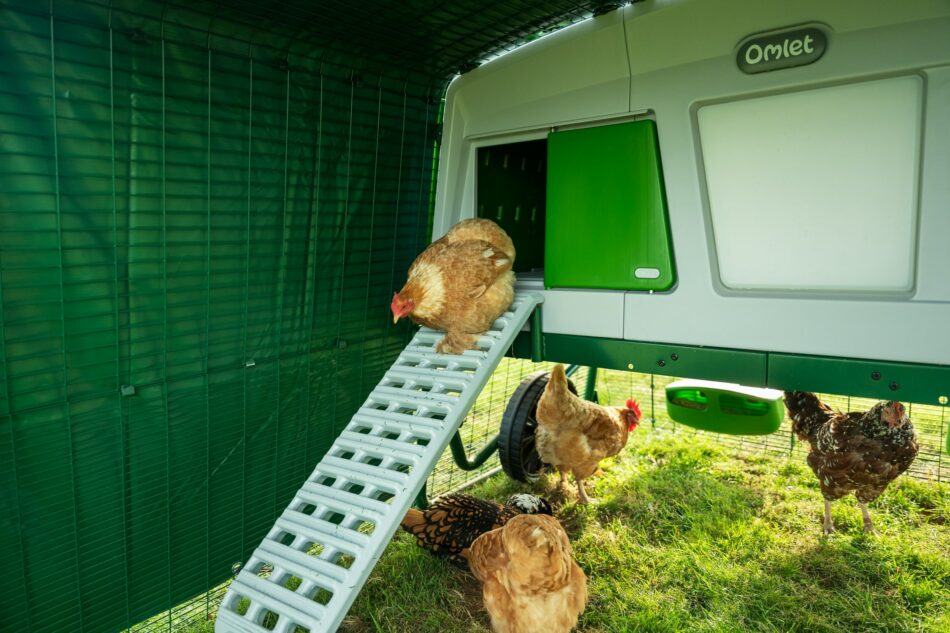
Chicken sounds and what they mean
A calm, gently rising borrrrb
This is the chicken sound hens make as they peck their way through the grass or chicken run, and it means two things. It indicates that the chicken is enjoying the endless search for quick snacks, and it’s also telling the other birds ‘everything is fine’. A flock of hens saying borrrb together sends out the reassuring message that there’s nothing to worry about.
The cluck-cum-squawk
This brief, excited cry usually means that there has been some sort of confrontation, usually between a meek hen and a more dominant one who has muscled in to see what snacks the more timid bird has found. The sound is also used if a hen is surprised by something, such as the chicken-run door opening suddenly.
The ‘squawk bomb’
This is when the hen clucks, gobbles and squawks in one hysterical flurry. It sounds as if the bird is about to explode in a cloud of feathers. This is the chicken’s main alarm call, expressing fear and also telling the other birds to run. The causes can be vehicles, dogs, people trying to pick up the hen, or predators.
Cackling
This is the name often used for the familiar Buk-buk-buk-badaaak! call. Repeated several times, and loudly, it is the sound many hens produce after laying an egg. The hen moves away from the egg and then begins cackling. It is thought to be a way of luring potential predators away from the egg and the nest.
Buk-buk-buk (but with no badaaak!)
This slightly angry and persistent sound is often made by a hen who wants to sit in her favourite nest box but finds it occupied. It’s meaning is a combination of “I’m here!” and “Get out!”
Growling
If a hen is broody and doesn’t want to move from her nest box, she will make a hissing, growling sound. This simply means “Don’t touch!” and “Go away!”
Chick-chat
A hen hatching eggs will mutter various gentle clucking sounds to communicate with the chicks and reassure them. Once the chicks are hatched and running around, she tells them where the good scratching and pecking places are by saying tuk-tuk! (Cockerels use this sound too, to tell the hens that they have found a good foraging spot). Mother hens also have an insistent Rrrrrr call, which is the chicks’ cue to come running if the hen senses danger.
Crowing
This is cockerel territory, the classic cock-a-doodle-doo – although some hens get the crowing habit too. Crowing says several things. It means a new day has dawned, and it’s time to be up and scratching/pecking. It also tells the world that this is the cockerel’s territory, and that these hens are his. If there is more than one cockerel, the subordinate ones will only crow when the boss has crowed. Crowing usually hits 90 decibels, or even more!
Help!
A hen separated from the flock will make an alarm call. The sound is similar to the ‘cackling’ that announces a new egg. It is thought to be an SOS call to the cockerel to come and save his lost hen. There will be a strong element of danger if there are predators around, so it’s a risky strategy for a lost chicken.
Buzzing
First thing in the morning, with the chicken coop still locked, the hens will begin to make repetitive, buzzing clucks, which may rise in volume as the minutes pass and the doors remain shut. This sound simply means “Let us out – there’s lots of pecking and scratching to be done!”
With this knowledge of chicken chit-chat, you will be able to tell what your girls are talking about, even if you can’t actually see them. It’s an all-day, non-stop conversation!
Want to find out more about the wonderful world of chicken keeping? Take a look at the Omlet Chicken Guide for tips, tricks and advice! You can also visit the Omlet website to find everything you need for your flock including Chicken Coops, Walk in Chicken Runs, Chicken Fencing and more!
This entry was posted in Chickens
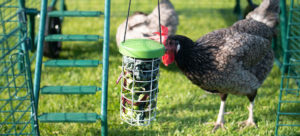
Here’s why the Caddi is the perfect choice for your treat-loving pets…
- The Caddi Treat Holder decreases the rate at which your pets will eat their treats. Slower treat release through the gaps in the holder means more satisfaction for longer, and prevents over indulgence.
- The Caddi Treat Holder swings around and creates a rewarding, interactive game to keep your pets entertained, which is especially great for rainy days! Your pets will love the stimulating experience of foraging for their treats, and enjoy hours of rewarding fun.
- The Caddi allows you to feed your pets treats without having to throw them on the ground. This improves run cleanliness, reduces food waste and prevents pests, as well as being a healthier solution for your pets. Simply hang the Caddi from the roof of your pet’s run with the plastic hook and use the string to adjust the height to suit your pets.
- Endless treat opportunities! With the Caddi Treat Holder you can feed a range of fresh greens, fruits and vegetables to your pets, you can use it as a hay rack for rabbits, or fill it with pecker balls for hens. Get creative and reward your pets with exciting new flavours in the Caddi.
- You can save 50% on the Caddi Treat Holder until midnight on Monday, just by signing up to the Omlet newsletter. It’s a great deal for you, and an exciting new treat dispenser for your pets! Enter your email address on the Caddi page to claim your discount code.
Now available for just £4.99 if you sign up to the Omlet newsletter!

Terms and conditions
This promotion is only valid from 12/08/20 – midnight on 17/08/20. Once you have entered your email address on the website you will receive a unique discount code that can be used at checkout. By entering your email you agree to receive the Omlet Newsletter. You can unsubscribe at any point. This offer is available on single Caddi Treat Holders only. The offer does not apply to Twin Packs or bundles with Omlet Peck Toys or Feldy Chicken Pecker Balls. Offer is limited to 2 Caddi Treat Holders per household. Subject to availability. Omlet ltd. reserves the right to withdraw the offer at any point. Offer cannot be used on delivery, existing discounts or in conjunction with any other offer.
This entry was posted in Chickens
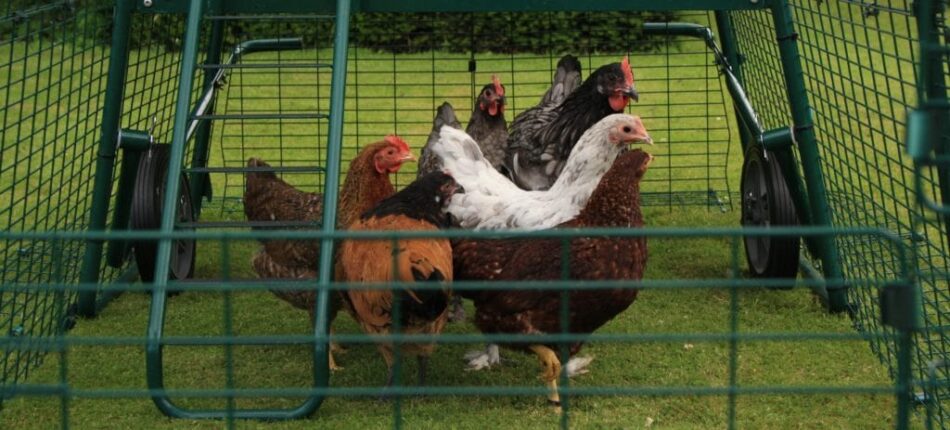
A flock of chickens can easily give the impression of peace and equality, but they don’t start out that way. There’s a “pecking order” among chickens that is established early on and can be challenged and even changed from time to time. Every flock of chickens, whether it consists of two birds or 200, has a pecking order. This natural hierarchy determines the top and bottom-ranking hens. Understanding the pecking order in chickens will help you make decisions about housing, how to set up the run, and look out for potential trouble.
What is a pecking order in chickens?
Adherence to a pecking order is a natural behaviour in chickens and doesn’t usually require human interference. It’s established by the more dominant birds asserting themselves – and the more submissive birds will fall into line. Dominant chickens will usually be first to the feeder and to roost, but will also ensure that the lower ranking members of the flock are taken care of. Much like a monarchy, most high-ranking hens will also see that their subjects are cared for.
Chickens that are raised together from chicks will have already sorted out their pecking order. But, if you’re adding more hens to an existing flock, be prepared to witness the pecking order sort itself out all over again. Each time new members are added to the flock, the pecking order will be challenged.
Interestingly, there is circumstantial evidence that hens’ combs may play a part in the war of the wattles. Hens with large, erect combs tend to be higher in the pecking order than birds with less impressive combs. But, every flock is different, and the pecking order can be challenged and can change at any given time.
Changes in the pecking order
Occasionally, another hen may challenge the top hen for the top place in the pecking order. This is common when new hens are added to a flock, or in established flocks when dominant hens go broody, get older, or become ill. Or, sometimes lower ranking hens will simply test their place among the flock.
Generally, the most aggressive or assertive hens will be at the top of the flock’s pecking order. But, when the situation demands it, dominant hens will have to defend their place at the top. Common behaviour among hens that are working out the pecking order includes:
- Squaring off to each other – sometimes with their feathery hackles raised along their necks
- Small squabbles of pecking or feather-pulling
- A loud commotion of squawking or clucking that lasts a minute or two
Sometimes a chicken seems to rise to the top with very few pecks involved. If a dominant hen is no longer around, the pecking order enters a state of flux, and there may be new outbreaks of feathered fisticuffs before the new order establishes itself.
Occasionally, hens will be overly aggressive or will gang up on a newly added flock member, or one that’s especially timid. Keep an eye out for dangerous behaviour like:
- Excessive pecking, to the point of drawing blood or giving another hen bald patches
- Keeping lower-ranking hens away from food or water
- Pushing lower-ranking hens out of the coop at night
If you notice a hen being bullied, you’ll need to isolate them until they regain their strength. Overly aggressive hens should be kept with other strong-willed hens, and should not be allowed in with a flock of very timid hens. It’s not often that a hen will take advantage of a higher rank, but those that do are very difficult to convince otherwise.
A healthy pecking order
Being top of the pecking order doesn’t mean a hen enforces a reign of terror. Top hens protect the flock by keeping an eye open for danger, lead the flock to new food sources, and signal when it’s time to head to bed. In healthy pecking orders, dominant hens make sure that everyone is in the coop at night and has a place to roost. Make sure your chicken coop has plenty of space for everyone to have a comfortable roost at night – a nurturing dominant hen will become stressed if the rest of the flock is in a state of unrest.
If you have a rooster in your flock, they’ll almost always be at the top of the pecking order. Their natural protective instincts is what can make them aggressive (even to their human caretakers), but is also what keeps them in an elevated position in the flock. Sometimes an assertive hen can rank over a more submissive rooster, but this is very uncommon. Keeping with the rule of thumb of no less than 10 hens for each rooster in your flock will help the pecking order and the overall well-being of your hens in balance.
Be sure to give your flock plenty of room outside of the coop as well. A walk in chicken run can be expanded to accommodate growing flocks and can utilize vertical space for hens to work out their differences. Hens will maintain a healthy pecking order on their own, but by keeping their stress low and giving them plenty of space to spread out, you’ll help them keep the peace.
Your flock and Omlet
Just because chickens are self-sufficient in establishing their pecking order doesn’t mean that a little human help isn’t beneficial. By giving them a safe and roomy home like the Eglu Cube chicken coop and a spacious outdoor area with the Walk In chicken run, your flock will be comfortable and safe from external stressors that could upset their natural order. With our ingeniously designed chicken products, your chickens will be able to live their best lives as close to their innate behaviours as possible.
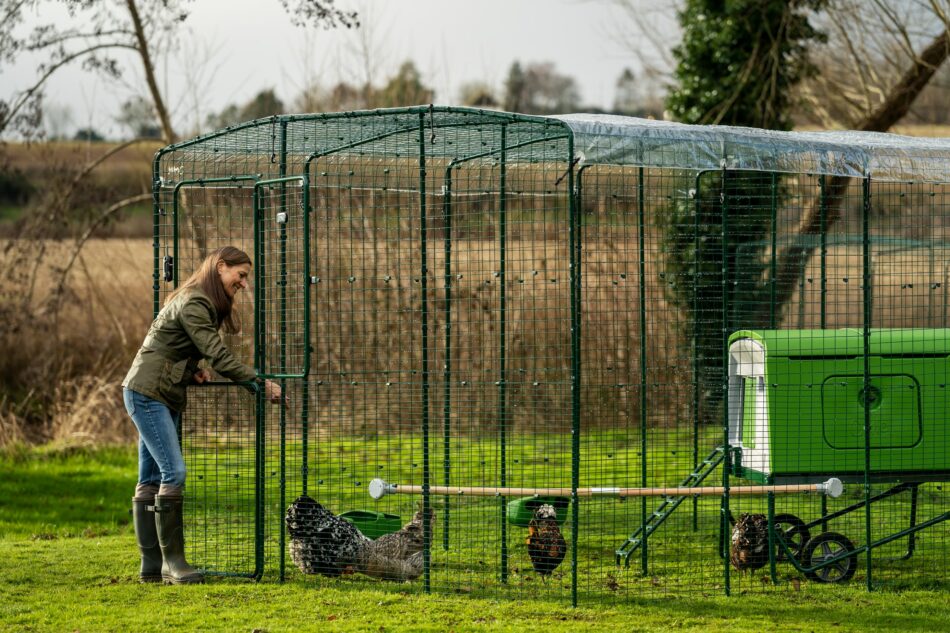
This entry was posted in Chickens
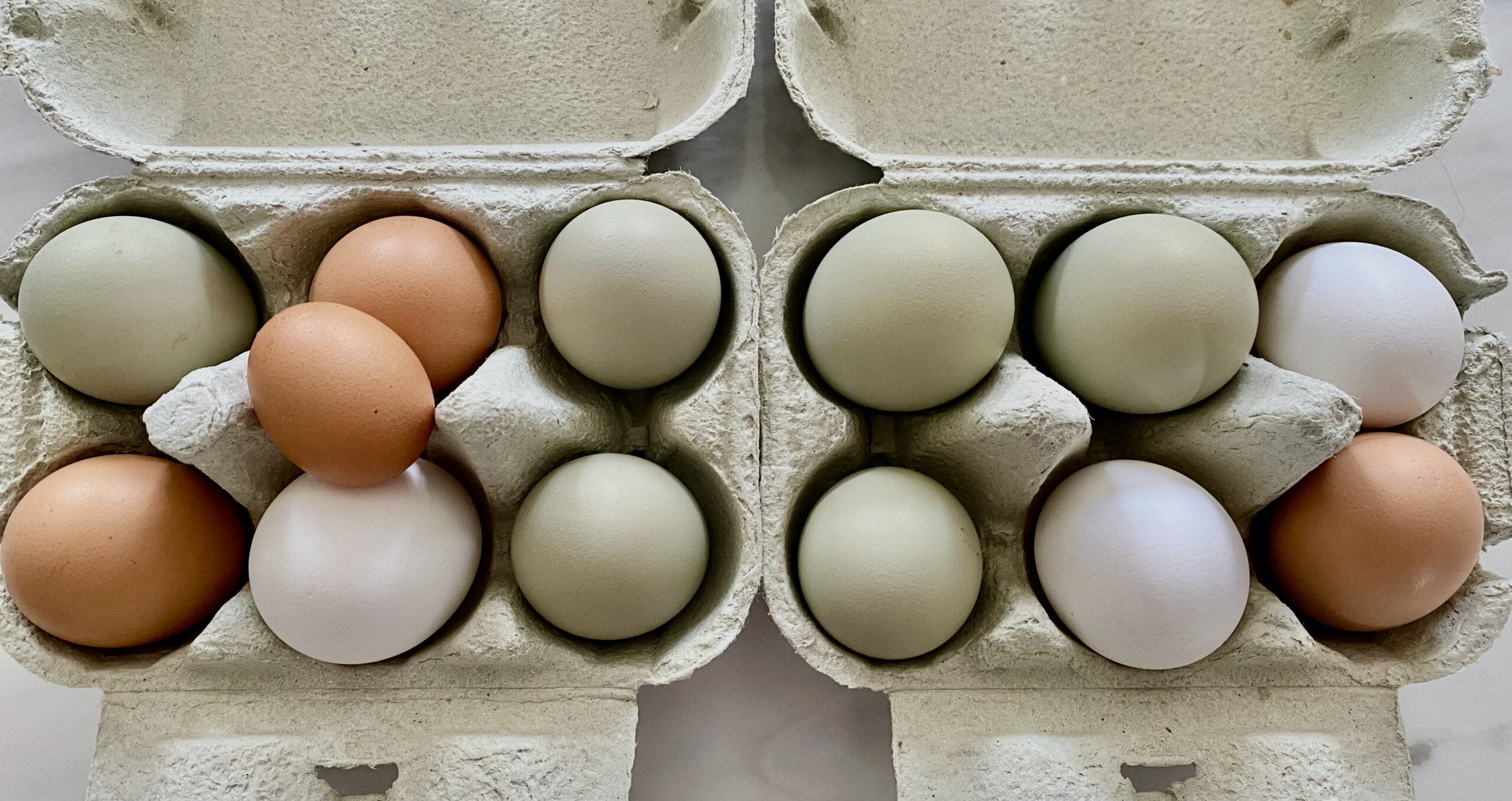
We are all used to the idea of fresh food being clean and chilled, so surely the best method of storing eggs is to wash and refrigerate them?
The answer is ‘no’. With a bit of ‘yes’ thrown in. Although the collective knowledge of chicken keepers is vast, there is still debate about the best way to store eggs.
We’ve gathered the various ends of the argument and summarised them below. Welcome to the debate!
Washed eggs?
Unless the eggs are soiled – which is the result of mud or chicken poo in the hen house, rather than dirt deposited during the actual laying – they do not need washing. A freshly laid egg has a shell covered in a protective ‘bloom’, called the cuticle, and this acts as an antibacterial defence system. If it’s washed off, the protection is washed off too. However, if the eggs are then stored in clean boxes, this won’t be a huge issue.
Eggs with dirty shells should be wiped clean, and it’s a good idea to use these soiled ones first – mainly to keep the egg box or egg-skelter looking pretty!
Chilled eggs?
Some chicken keepers keep their eggs in a refrigerator, while others believe this is unnecessary. So what’s the best advice?
There are two rules of thumb – keep them below 20°C, and keep them away from strong odours, as these may affect the flavour. Other than that, it’s really up to you.
A study was carried out in 2013 by Food Test Laboratories in England, comparing the fate of two batches of supermarket eggs. The eggs were kept for two weeks, half of them in the fridge, and the other half at room temperature.
The eggs were tested for ‘usual suspect’ bacteria such as salmonella and listeria, at the beginning of the experiment and two weeks later. The results demonstrated why there is such divided opinion on the issue, as neither sets of eggs showed any signs of bacterial nasties, inside or out.
It’s the cuticle ‘bloom’ that keeps the eggs fresh and bacteria-free. If you’ve had to wash them, it’s probably a good idea to refrigerate them, as the shells will not be protected. Keep them in boxes on the fridge shelves, rather than in a fitted plastic egg tray in the fridge door (formerly a regular feature in new refrigerators).
Eggs don’t like being shaken, as it causes the egg whites to deteriorate and turn slightly watery. An egg that’s shaken by the constant opening of the fridge door is likely to lose its binding qualities in baking, and will look very sad, flat and watery in the poaching or frying pan. Fridge doors are the warmest part of the appliance too, and the area of the fridge where temperature fluctuates the most, which isn’t ideal for egg storage.
Egg basket or box?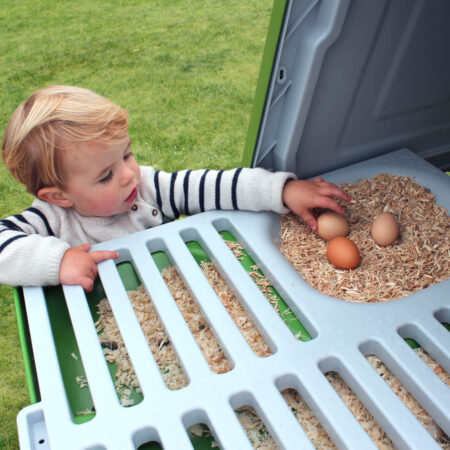
Eggs kept outside the fridge can be stacked in boxes, with the oldest ones in the topmost boxes. This age factor is less easy to sort out if you keep the eggs in a wire basket, although these look great on display. Some chicken owners use colour coding dots, or even dates, to sort the young from the old. If you’re unsure about relative age, you can always use the traditional ageing method: place the eggs in a bowl of water, and watch how they sit. Very fresh ones will lie flat on the bottom, while older ones will have their pointed ends raised. Ones that are way past their use-by date will float.
Another advantage of egg boxes is that you can store the eggs with their rounded ends at the top. This keeps the yolks centred, which makes them look their best if you’re hard- or soft-boiling. However, if most of your eggs end up in cakes and quiches, this isn’t going to be an issue.
An egg skelter is another attractive way of storing the fruits of your hens’ labours. These keep the eggs in age-order, and they look great too.
Storing shelled eggs?
Any leftover raw egg can be stored in the fridge in an airtight container. It should be used within three days. Stored yolks should be covered in water to prevent them drying out. The water can be poured away before use.
Uneaten cooked eggs (i.e. hard-boiled) will always leave an ‘eggy’ whiff in the fridge. This is caused by hydrogen sulphide, a gas that forms when eggs are cooked (you’ll notice it’s never present in raw eggs). Although not exactly pleasant, the gas is harmless. Eggs stored in this way should be eaten within one week.
So, the main takeaway here is that eggs can be stored wherever you want them to be stored. As long as you keep them away from heat, strong odours and too much shaking, you’ve got the storage conundrum cracked!
This entry was posted in Chickens
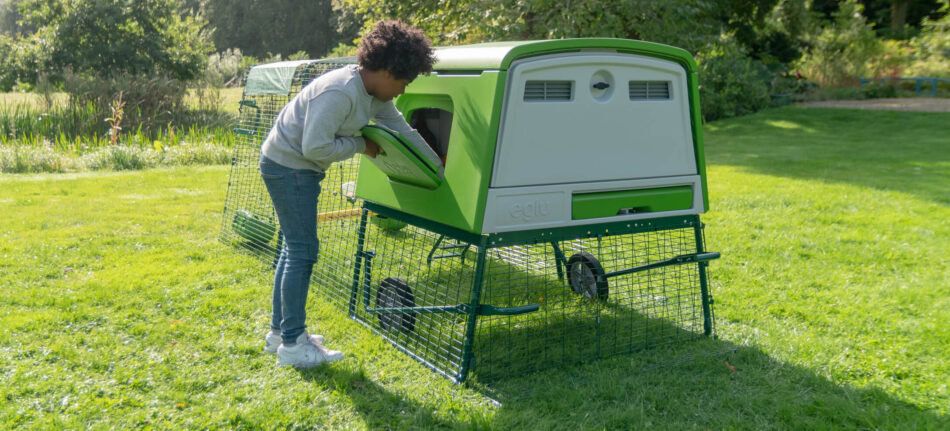
Wondering how to keep your chickens cool in summer? The longer, warmer days are upon us, and pretty soon your hens will start feeling the heat. Overheating and heat stress are real concerns this time of year. We’ve compiled tips and tricks to help you combat the heat and keep your hens safe this season.
Keep your chickens’ coop cool
Keeping your chickens’ coop cool by moving it into a shady spot in your garden is one of the best ways to keep them cool. This could be under a tree or on a side of your house that doesn’t get as much sun. The Eglu chicken coops are so easy to move that you can effortlessly relocate your garden flock as the sun moves. Omlet coops also utilize draft-free ventilation to help to keep your hens cool.
Change the water at least once a day
Your chickens will drink more in summer in an effort to stay hydrated. To keep their water fresh and cool, change the water in your flock’s chicken drinker at least once a day during the hot summer months. Place the drinker in a cool, shady spot in the run to help keep algae levels and water temperature down. Try adding ice cubes to their waterer several times a day during especially hot days.
What to feed chickens in summer
Dried corn and grains take longer to digest than pellets or fresh food, which increases your hens’ metabolism and heats their bodies. Chickens will not need to eat as much in hot weather, but your garden will be full of bugs and vegetation this time of year when they feel the need to eat.
Watch your chickens closely
Hens can overheat quickly in hot weather, so it’s important to not leave them unattended for more than a few hours a day. Summer is usually a time for families to travel, but be sure to get a chicken sitter for your flock when you go out of town. Your flock will be drinking a lot more water as the weather heats up, so refreshing their water at least every 8-10 hours is a necessity to keep it fresh and cool.
In the warmer weather, it’s especially important to watch for signs of heat stress. Keep an eye out for signs of overheating, like:
- Open mouth panting
- Lethargy
- Loss of appetite
- Droopy appearance or uncoordinated movements
Any overheated hens should be removed from the coop and placed in a cooler area. Don’t cool your chicken down too quickly, as they can go into shock. Call your veterinarian about any severely dehydrated or overheated hens.
Cover their run, but not completely
Covering your chicken run might seem like a good idea to create a shady spot, but if you don’t let air circulate, it’s likely to become a balmy tunnel of warm air. It’s important to have ventilation so that fresh air can move around. Cover part of your flock’s run to offer a shady area, but be sure to leave plenty of uncovered space for breezes. Our green chicken run covers block the sun to give your hens ample shade in their run.
Our Eglu chicken coops’ ingeniously designed ventilation system allows air to circulate in the coop at all times — keeping it cool and fresh even on the hottest days. This method works much better than wooden chicken coops.
Postpone playtime
Interaction with the chickens might lead to more movement for them, which increases their body temperature. If you want to spend time with your chickens or need to pick them up for health checks, plan to do so early in the morning or late at night when it’s cooler.
All chickens are different
Some chicken breeds aren’t as heat-hardy and will need additional support in the summer months. Keep a close eye on breeds like Polish or Silkies in the heat, as their head plumage can prevent them from seeing water sources easily. Keep plenty of water at multiple levels around the run to ensure your hens always have access to fresh water.
Can chickens get wet in summer?
Chickens don’t mind a light sprinkle, but saturated feathers can be dangerous. Wet feathers get weighed down and don’t allow for airflow. Hens will fluff out their feathers to create a layer of insulation against both the heat and cold — much like the technology that our Eglu coops employ. Don’t hose your hens down in the heat, but instead offer ice packs in their coop or nesting areas for them to lay next to.
Do chickens stop laying eggs in summer?
You’ll probably get fewer eggs than normal during the warmest weeks of the year. This is completely normal — chickens won’t lay as much when they are hot, and some may go broody and stop laying completely. Although the eggs won’t go bad if you leave them in the nest box of an Eglu for a day, eggs in the nest can encourage broodiness and result in egg eating. It’s a good habit to collect all eggs daily.
Should I clean my coop more in summer?
It’s always important to keep the coop nice and clean for your hens, but even more so in summer. Parasites and pests are more prevalent when it’s warmer, but make sure to use a chicken-safe disinfectant and dust roosting bars with parasite powder to keep pests at bay. Eglu chicken coops can be cleaned quickly and easily to diminish the presence of parasites. Simply pressure wash and dry with a clean rag to have a sparkling clean, mite-free coop in minutes. Unless you have hens with an active mite infestation, Eglu chicken coops do not need to be treated for mites. If cleaned daily, the smooth plastic design of our Eglu chicken coops does not offer a hospitable environment for mites.
Keep chickens cool with Omlet
Make sure that your chickens are well-equipped for any season with Omlet’s range of chicken products. Keep frozen treats in our chicken treat dispensers to make summer days more bearable, and offer shady spots with chicken run covers. With our expertly crafted chicken products, your flock will be safe and comfortable all year round.
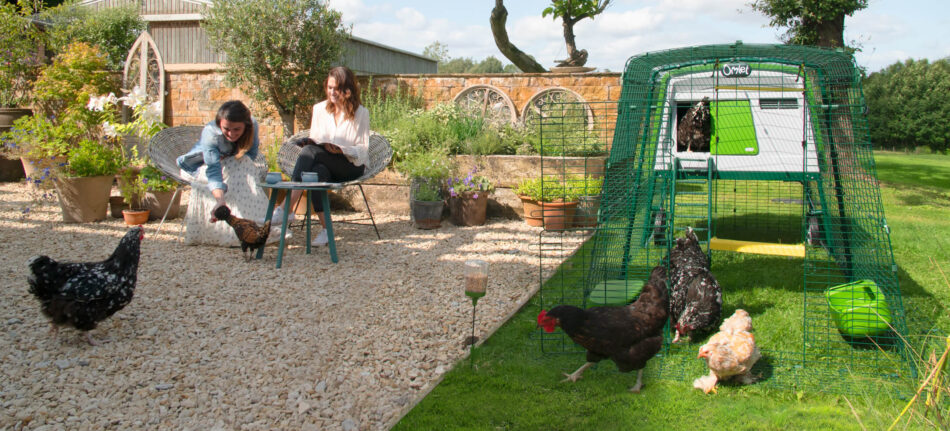

This entry was posted in Chickens
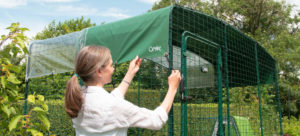
We often get asked which is the best cover for an Eglu run to keep pets comfortable all year round. Read our simple guide below so you know how to help your pets in all weathers!
Summer Shades
These shades are a thinner cover material which offers protection from the sun, without creating a tunnel where heat can build up inside the run. These are smaller than the winter covers to allow better airflow through the run for ventilation. Move the summer shade around the run to suit the time of day and your hens’ routine. You may wish to change this for a Clear or Combi Cover in summer when there’s rain on the way!
Clear Covers
The Clear Covers allow for sunlight to flood your pet’s run, while also offering protection from rain. This makes them ideal for spring and autumn, so the run is light and warm with sun, but also protected from unpredictable wind and rain.
Combi Covers
Get the best of both worlds, with shade from the sun on one side and light coming in the other, as well as full wind and rain protection on both sides. The Combi Covers are half dark green, heavy duty cover for extreme wind and rain protection, and half clear cover to let in sunlight and warmth and to let your pets see when you are bringing them treats!
Heavy Duty Covers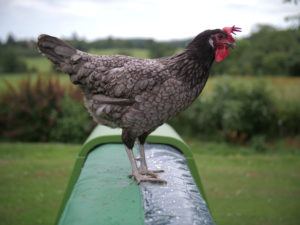
For strong, hard-wearing protection against the worst of winter choose heavy duty covers. Even when the temperature drops to single figures, the rain and wind batters your pets home, or a deluge of snow covers your garden, the dark green, impenetrable heavy duty covers offer sturdy weather protection. Your chickens or rabbits will be able to hop around the Eglu run in complete peace, without getting cold, damp or wind-swept!
Extreme Temperature Covers
Chickens and rabbits are very efficient at keeping themselves warm in cold weather, and the Eglu’s twin wall insulation will assist them by keeping cool air out and warm air in, but when temperatures plummet below freezing for multiple days in a row, they may appreciate a little extra support. The Extreme Temperature Blankets and Jackets add another insulating layer, like your favourite wooly jumper, without compromising the ventilation points around the coop.
This entry was posted in Chickens
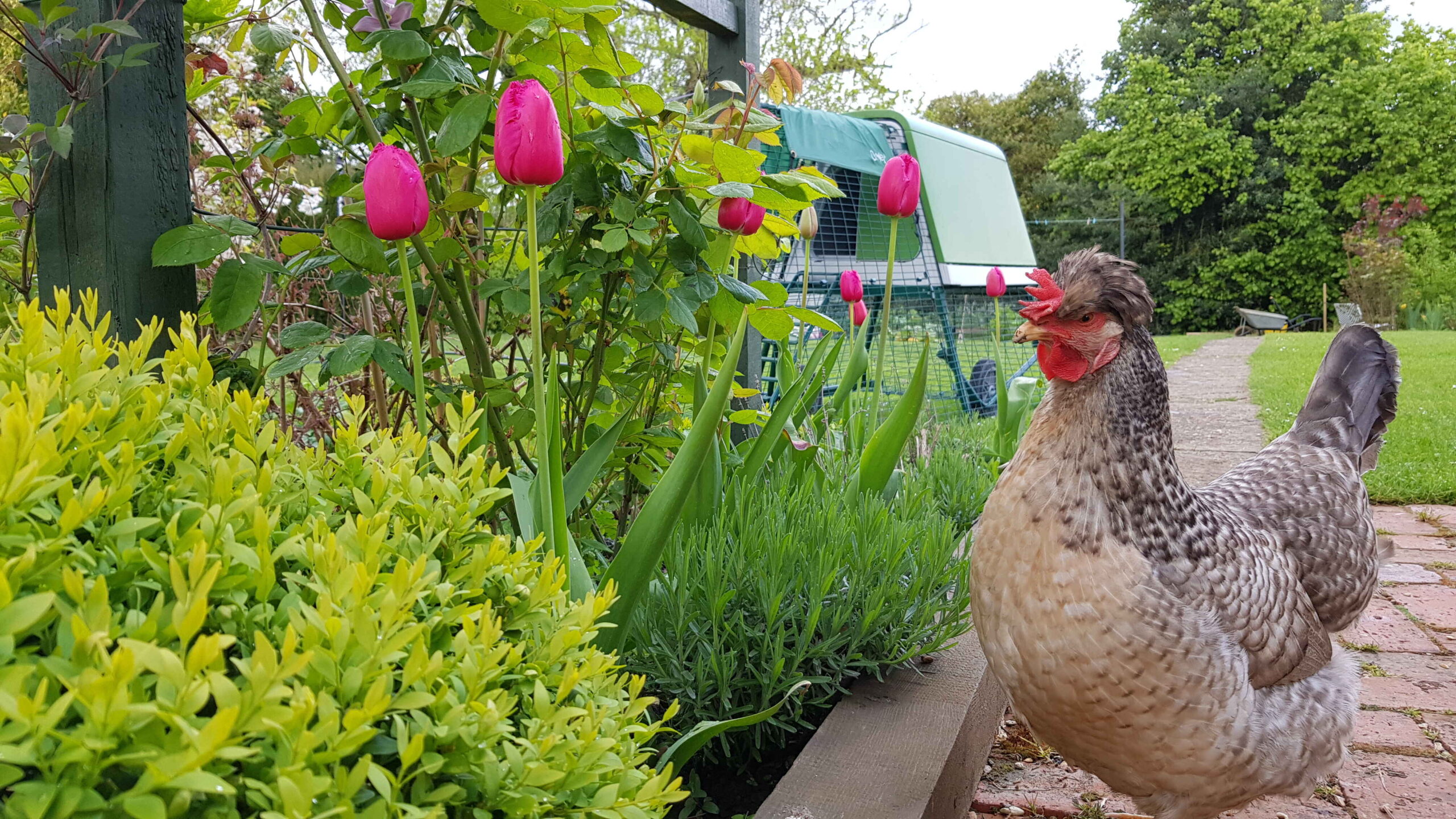
The Eglu Go UP is the perfect solution for keeping a small flock of chickens in your garden.
1. Fertiliser
Chicken manure is one of the best things you can use to improve the soil in your garden. Once composted, chicken droppings are full of nitrogen, phosphorus, potassium and other important nutrients, and increases the soil’s ability to hold water. This means more beautiful flowers, and bigger and more delicious vegetables!
Collect your chickens’ droppings and compost for up to a year before using the manure.
2. Pest Control
Chickens spend their days scratching around the garden in search of yummy treats. They love finding beetles, grubs, caterpillars and ticks. Sometimes they even go for those pesky slugs! This is an extremely environmentally friendly way of getting rid of pests, with the added benefit of happy and content hens!
3. Rotation
Want to create a new bed in the garden? No problem, get the chickens in to do the job for you. If there’s one thing they do well it’s tilling and turning. Spread some chicken feed where you want the soil to be moved and aerated, or leave a pile of leaves that you would like spread over a resting bed, and you can be sure that the chickens will have sorted it in half the time it would take you to source a rotavator.
4. Free Weeding
In a similar way, if you want to clear a bed of weeds or grass, get your chickens on it. They will munch on weeds and dead matter you haven’t already removed, leaving the fun bits of gardening to you!
Although clever, chickens are however not able to differentiate weeds from the plants and seeds you actually want to keep, so it’s best to keep them off flower beds and veg patches where you are growing things you actually want. Use a good fencing to limit the chickens to certain parts of the garden.
5. Added Calcium
One of the best things about keeping chickens is the delicious eggs they provide you with. But did you know that eggshells can be highly beneficial to your garden? Eggshells are made of calcium carbonate, and are a perfect way to introduce minerals to your soil. Calcium is essential for building cell walls, making sure the plants stay strong and healthy.
Grind up your shells with a mortar and pestle and spread on your compost, or straight in your bed.
6. Great Company
With chickens around you will have even more reason to spend time in the garden. It’s so much fun seeing them scratch around and hear their friendly chatter, and they are great company for any keen gardener. People even claim that being around chickens relieves stress and leads to better mental health.
So what’s stopping you? Chickens are the perfect pet you and your garden needs.
This entry was posted in Chickens
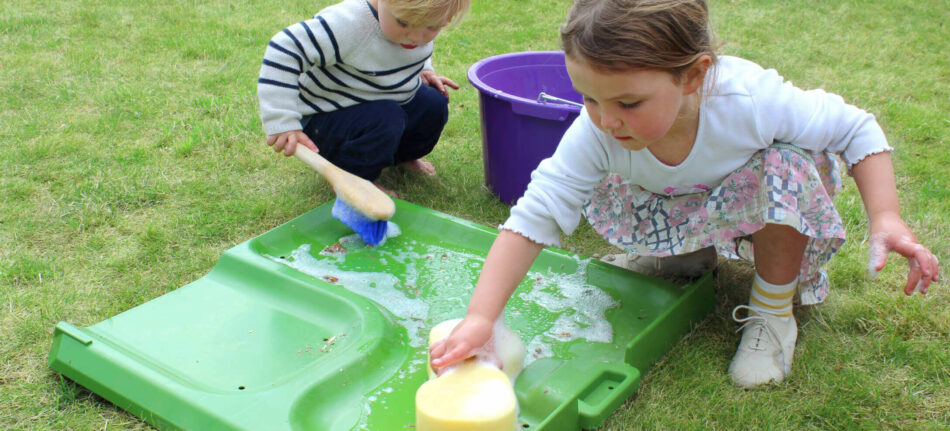
It’s red, it looks like a spider, it lives in huge colonies, and it creeps out at night to suck your chickens’ blood. As nightmares go, this one’s pretty alarming – until you realise that it’s one that you can easily wake up from. The creature in question – the Red Mite – is less than a millimetre long, and it’s not difficult to banish from your chicken coop.
The Red Mite is able to live – and feed – on a variety of hosts, including humans, given half a chance. But it is it’s fondness for wild birds that brings it into contact with one of its favourite targets – your chickens. If there are birds in the garden, there are probably Red Mites too.
Know Your Enemy
The Red Mite, Dermanyssus gallinae, is a parasite that hides in dark corners of the chicken shed and scuttles out at night in huge numbers to suck blood. When fully grown, they are about 0.75mm, with spider-like legs. Before feeding, the mites are greyish-brown rather than red – the colouring comes from the blood they suck. Once engorged, the mites scurry away back to their hiding places. They are patient, too, and have been known to survive for up to 10 months in empty chicken sheds.
Infested hens will eventually develop scabs and wounds, suffer from anaemia (caused by blood loss and manifesting in pale wattles and combs), and may begin to lose feathers. Egg production will plummet, too. If the hens are young, in severe cases the blood loss and physical shock can prove fatal. One of the problems of diagnosis is that the mites are often in hiding when you examine the bird, rather than sitting in plain view (like a louse or flea, for example). These physical signs in the bird should prompt you into action though, and checking the mites’ potential hiding places is straightforward.
If the mites appear to be living on your chickens full time, rather than disappearing in the day, you might have an outbreak of Northern Fowl Mite. Same issues, different beast – and the advice given in this article applies to these bloodsuckers too.
How to be Mightier than the Mite
Because they normally feed at night, you may not spot the mites at first. You can, however, look for their hiding places. Corners and crevices in wooden henhouses are a favourite, and under roosting perches. Once discovered, you need to zap the mini vampires with a hen-friendly Mites, Lice & Scaly Leg Treatments for Chickens. There are two types of product aimed at eliminating the beasties – ones that you spray or dust on the hen house and its fittings, and another that you apply directly to the birds.
All bedding should be removed from an infested coop, and the whole structure should be washed with hot water – a power-hose is a good weapon in this battle – before being treated with an anti-mite preparation.
Once the mites have been banished, prevention is the best way of keeping control of the situation. Regular washing of the chicken shed and any other concrete, plastic or wooden areas of the chicken run will help. This is particularly important in the warmer summer months, when the mite population tends to boom.
Some chicken breeders have reported good anti-mite effects from carbon dioxide, either in the form of a ‘dry ice’ fumigation or direct spraying, but there is not yet any formal veterinary rubber-stamping of these procedures.
Another fool-proof way of banishing Red Mite is to keep your hens in a coop that doesn’t have lots of corners, nooks and crannies – i.e. something plastic rather than wooden. Plastic chicken sheds are easier to clean and keep hygienic, and the Queen of Coops is the Eglu Cube Chicken Coop.
So, you can’t keep the wild birds and their mites away, but you can easily stop them regaining a hold amongst your flock. Once the nightmare is banished, both you and your hens can sleep easy at night.
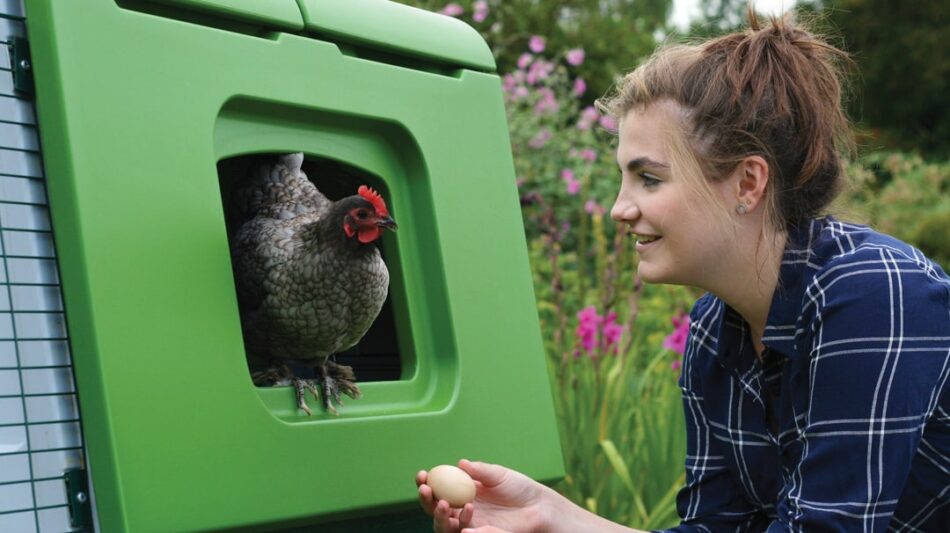
This entry was posted in Chickens
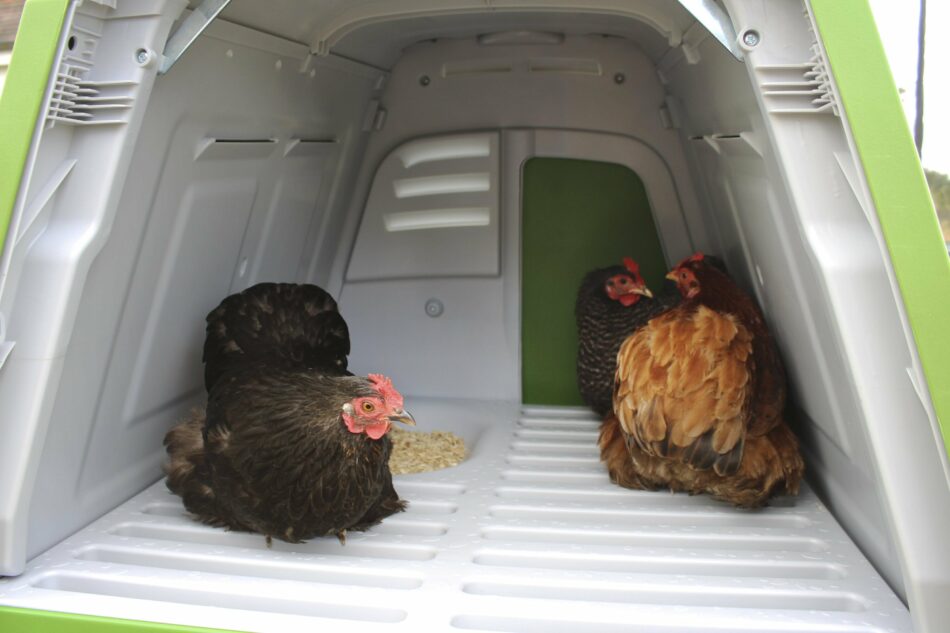
Most hens lay their eggs with minimum fuss. They might make a bit of noise to announce their egg-laying achievement but will soon return to the daily business of exploring and scratching for food. Some hens, however, do make a bit more fuss. To be more accurate, these hens are known as broody. A broody hen is one who sits on her egg with every intention of staying there until it has hatched – no matter whether the egg is fertilised or not. This is very useful if you want to hatch some chicks, but otherwise, it can be a problem. So then, how do you stop a hen from being broody?
The cause of broodiness
The cause of broodiness is linked to body heat, backed up by maternal instincts. Hens who are cooped up together in a hot henhouse may suddenly heat up to a level that makes them think “I’m going to hatch an egg!”. Certain chicken breeds seem more susceptible to broodiness than others, with the Silkies and Cochins being particularly moody-broody.
Signs of broodiness
A broody hen undergoes a personality change. The most obvious sign of this is her refusal to leave the nesting box. She’ll sit there with the air of a bird who will happily wait until Doomsday for the egg to hatch. This misplaced dedication will also make her grumpy and liable to peck or cluck angrily if you try to move her.
When you do manage to oust her from the box, she’ll simply head back there again and resume her brooding. Once she feels established in her new maternal role, she will fluff out her feathers and may begin to self-pluck her chest feathers to line the nest.
How to stop a hen from being broody
Time to get moving
Appearances can be misleading. Your hen may look as though she’ll sit in the box for eternity, but in reality, she’ll only stay there – usually – for three weeks. This is the length of time it takes a chicken egg to hatch. This means, if space allows, you can simply let her brood for 21 days, and once the mood lifts, she’ll return to business as usual. But, if you don’t have a cockerel and don’t want to rear your own chicks, this can be frustrating and you’ll want to break your hen from her broodiness.
You also need to make sure your hen gets enough food and drink during this time, which can be difficult for a hen who doesn’t want to leave their nesting box. This may involve forcibly removing her from the box and shutting it off until she has taken refreshments. Be sure to collect any eggs immediately when you do get the opportunity and be sure to always wear sturdy gloves as a precaution when attempting to move any broody hen. This will prevent your hands from getting pecked!
Try frozen veg
A common anti-broody trick is to place a packet of frozen peas or sweetcorn kernels wrapped in a blanket or tea towel underneath the hen in the nest box. Crushed ice cubes in a bag will do the trick, too. This has the dual impact of cooling the chicken down and making life in the nest box too uncomfortable for brooding.
Nest box obstacle course
Sometimes a simple obstacle such as a plant pot or a couple of bricks will have the desired effect. If the hen can’t access the nest box, she can’t sit there and brood. Fortunately, the Eglu Cube chicken coop has a central divider with a sliding door, which means you’re simply able to close the nest area off from the rest of the coop.
Set up a broody enclosure
Some chicken keepers use a so-called “broody enclosure” to break the habit. This is a wire cage or crate, in which the chicken is placed along with food and water. After three days, this gentle form of solitary confinement will usually break the broody habit. The signs that the brood mood is over are obvious – the hen will stop fluffing out her feathers and will stalk around the cage, rather than sitting and brooding.
Fancy chicks?
Then again, you could purchase some fertilised eggs and let the broody hen resume as she was. If you do want chicks, this is by far the easiest, and most natural way of producing them – under the fluffy belly of a broody hen.
Omlet and your hens
At Omlet, we design products that help find solutions to all your pet questions, like what’s the best coop for a broody hen? With unique products like the Omlet Eglu Cube chicken coop and Walk In Chicken Runs, our expert designers strive to continue creating the best environments for all pets – feathered or furry.


This entry was posted in Chickens
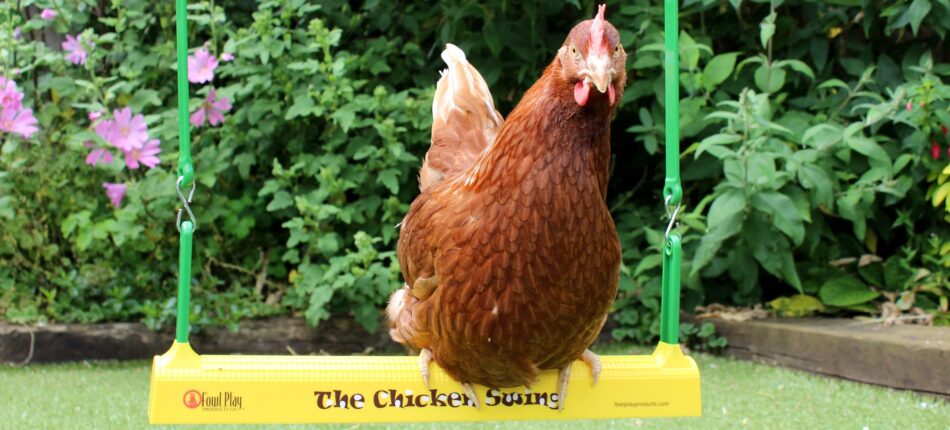
Roosting high up in trees comes natural to chickens, as that is one of the safest places to rest if you’re a chicken in the wild. And doing so on gently moving, or even swinging, branches makes you an even more difficult target for predators. So instinctively your birds should be happy to jump straight up on their Chicken Swing!
With that being said, chickens are vulnerable and clever creatures, which means that they can be wary of new things. They don’t like being the first to try something, so if you’ve got your flock a new toy and are disappointed they don’t seem particularly interested in it, you might have to help them take the leap!
Setting up The Chicken Swing
The Chicken Swing is cleverly designed to make it as easy as possible for chickens of all ages to use it. The base of the swing has a texture resembling a corncob, which makes it more grippable than a smooth plastic surface.
Make sure you place the swing free from any obstructions such as walls, mesh or other things on the run. Choose a sheltered spot under cover so the hens can do their swinging no matter the weather!
Eventually you ideally want the Chicken Swing to sit above the chickens’ heads, so that they will be able to swing without the risk of bumping into one of their friends. It’s no problem for a chicken to jump up a few feet, but to make it as easy as possible in the beginning, start with the swing close to the ground. The Chicken Swing is lightweight enough that if it were to hit one of your hens, it won’t hurt them.
You won’t need to train all your chickens to get on the swing. They are flock animals, so if you get one of them to show the others how it’s done, there’s a high chance the others will follow shortly!
Letting your chickens have a go
So choose your most adventurous chicken and place her on the swing, which at this stage should be hanging very low to the ground. Give her something delicious straight away, so that she associates the swing with yummy treats. Do this a few times until you feel she’s comfortable perching on the swing. At this point, push the swing slightly to get it moving. Reward the chicken every time she swings towards you. Push a bit more every time you’re trying, and start lifting the Chicken Swing higher and higher above the ground.
If the chicken at any point seems stressed or anxious, stop the training, let her down and go back to basics. It’s important that she only has good feelings associated with the swing!
It’s not guaranteed that all chickens will warm to the swing, it’s just a fact you have to accept. Young chickens are in general more likely to take risks and learn new things, but personality plays a big part, so you’re not automatically going to succeed just because you’re introducing the swing to chicks. However most chicken will, after some persuasion, absolutely love swinging, and it’s worth a bit of work when you see your girls queueing up for their go!
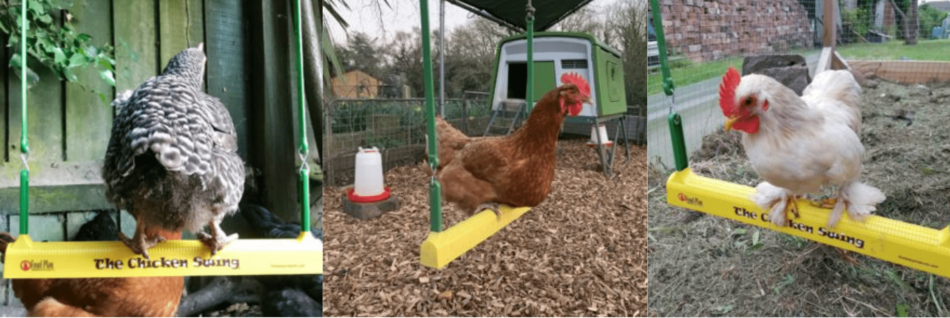
This entry was posted in Chickens
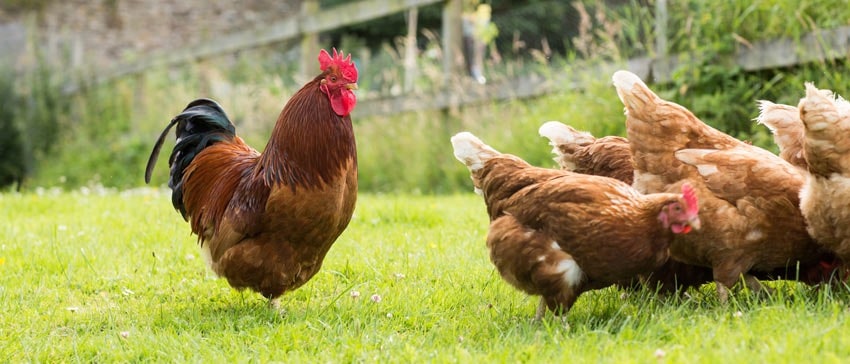
Most chicken keepers limit their attentions to hens and eggs. Roosters – or cockerels, as they are often called in the UK (and definitely not to be confused with roasters!) – are simply not on their tick list. After all, roosters are territorial, keen to defend their flock of hens, and famously noisy first thing in the morning.
But they are also beautiful birds, and if you intend hatching your own chicken eggs, your hens will certainly need the attentions of a rooster.
There are several cockadoodle-dos and cockadoodle-don’ts to consider if you are thinking of adding a rooster to your flock.
First, the good stuff
Cockerels look fantastic as they swagger across their territory. Their huge combs and wattles quiver like jelly, their pointy rear-end feathers and ‘mane’ of spiky neck feathers are wonderfully showy, and their posture suggests someone who has just strutted onto the dancefloor to show off some amazing moves.
But it’s not all about beauty. Roosters always have an eye out for danger, and will fight off any intruder they think they can tackle. The bird is not silly enough to attack dogs or cats, but it will make it clear to them that they are not welcome, through body language and alarm calls. This gives the hens time to flee for shelter, and the rooster will beat the retreat too, if things start to look too dangerous.
A rooster will add harmony to a hen flock, making sure none of his birds are bullied, and keeping everything in order, a bit like a hands-off, benign sheepdog.
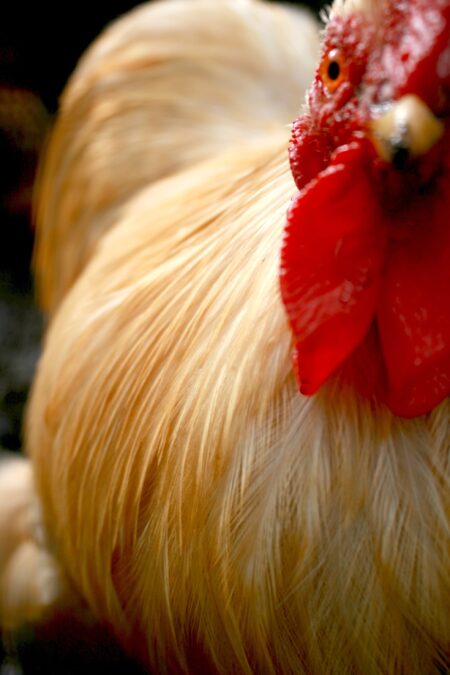
If you want to hatch chicks, hiring the services of a rooster is the only way forward. Fertilised eggs are still edible, as long as you collect the eggs on a daily basis. Any fertilised egg taken away from the warmth of a broody hen will not develop into a chick.
And the downsides?
If you live in a town or village, noise might be an issue with the neighbours. In many places in the USA, roosters are banned for this reason. However, if your bylaws don’t place an outright ban on male chickens, you’ll have the law on your side. But what about those irate neighbours?
The irony is that people who keep roosters – and many others besides – love the sound of early morning cock-crow. I raise my hand, as the author of this post, and admit to loving the sound of a rooster at daybreak – and I live in a village with half a dozen cockerels battling it out first thing in the morning. It’s a much better sound than car engines and slamming doors as people prepare for the working day. If people can live with the sound of road, rail and air traffic, surely they can get used to the wonderful sound of a full-throated rooster?
Sadly not, in many cases, and a crowing cockerel can be the subject of arguments and recriminations. So, so if you have nearby neighbours, it’s an issue you can’t ignore. Start off by speaking to everyone who live near enough that they will hear a cockerel crowing in the morning and see how they feel about the idea. You never know, they might be really excited about the prospect of a new alarm clock!
With that being said though it’s worth noting that roosters naturally crow, and if you (or your neighbours) can’t stand being woken up at the crack of dawn, you might be better off sticking to hens.
The rooster is not just a chicken version of a sheepdog, he’s a guard dog too. At the sight of any intruder, he’ll let you know. This is just the kind of vigilance you’d expect from a bird once declared to be the messenger of the sun god. And that’s a lovely image – he’s not crowing to annoy anyone, he’s crowing to announce the arrival of the life-giving sun. Who could say no to that?
This entry was posted in Chickens




 Most people would agree that the yolk is the best part of the egg. A double-yolker in the breakfast pan is therefore a very welcome sight!
Most people would agree that the yolk is the best part of the egg. A double-yolker in the breakfast pan is therefore a very welcome sight!




 Prevent infections
Prevent infections

























